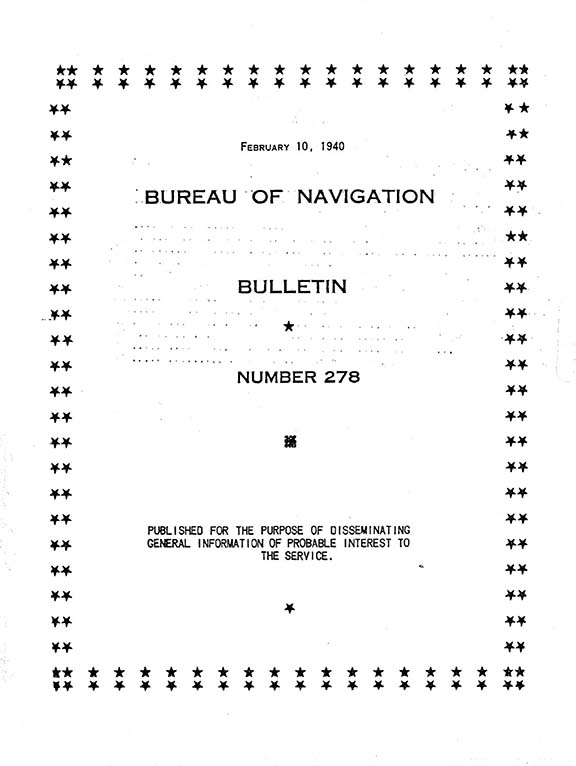authored by Nicholas Nemeth and Joshua Rasor
All Hands was an official monthly magazine that ran from 1922 to 2011. It was written by Navy for Navy. It had different names but was ultimately named All Hands in 1945. The magazine was terminated in 2011 but brought back as a web-based publication in 2013. There are over 150 issues. We have read all of them and pulled out any reference to Warrant Officers. This article chronologically documents each mention of Warrant Officers (WOs) and Chief Warrant Officers (CWOs). Let's dive into Part II, the 40s!
| February, 1940 |
|
A Chief Gunner was awarded the Navy Cross for efforts during a salvage operation following the sinking of U.S.S. SQUALUS on 23MAY39. |
| July, 1940 | 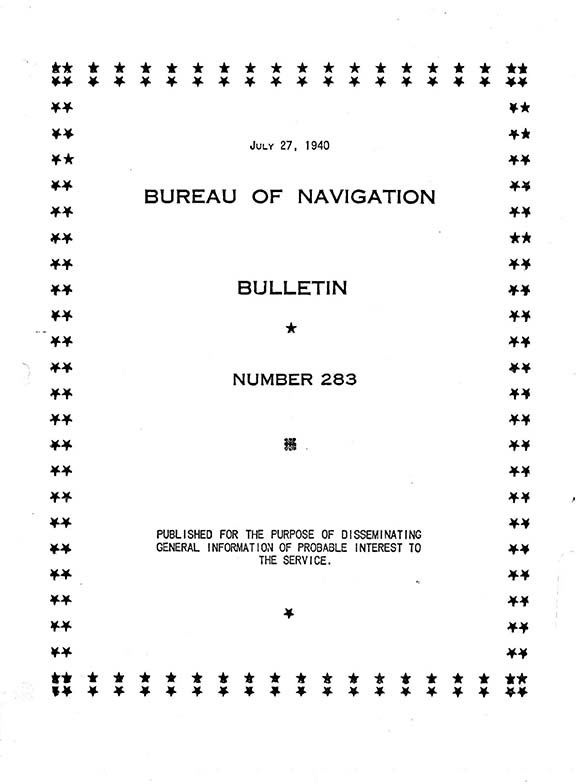 |
List of candidates for warrant ranks that are transferred from Temporary Waiting Lists to the Appointment List. |
| August, 1940 | 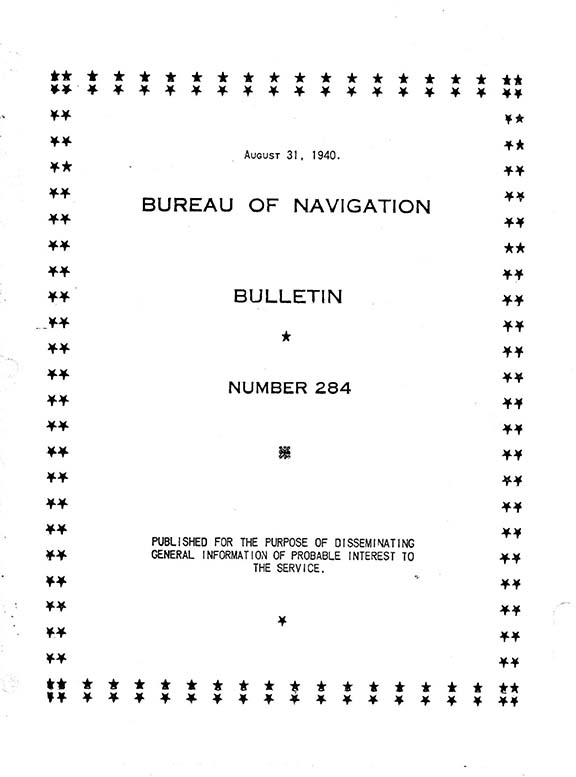 |
A future destroyer is being named after Warrant Officer, Purser, Samuel Hambleton. As an acting Lieutenant during the Battle of Lake Erie, he encouraged the men on deck and in personally working a gun until severely wounded. Another future destroy was named after Commodore Thomas Stevens who served as a Warrant from 1839 to 1849 before promoting to Lieutenant. |
| December, 1940 | 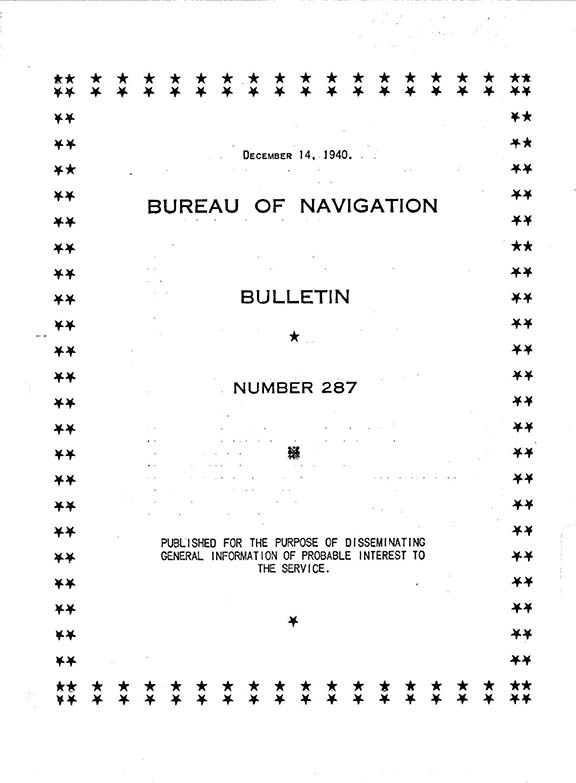 |
Chief Boatswain awarded Letter of Appreciation for acting as an officer to extinguish a fire and safeguard the ship. His efficiency, leadership, and courage were noted. |
| March, 1941 | 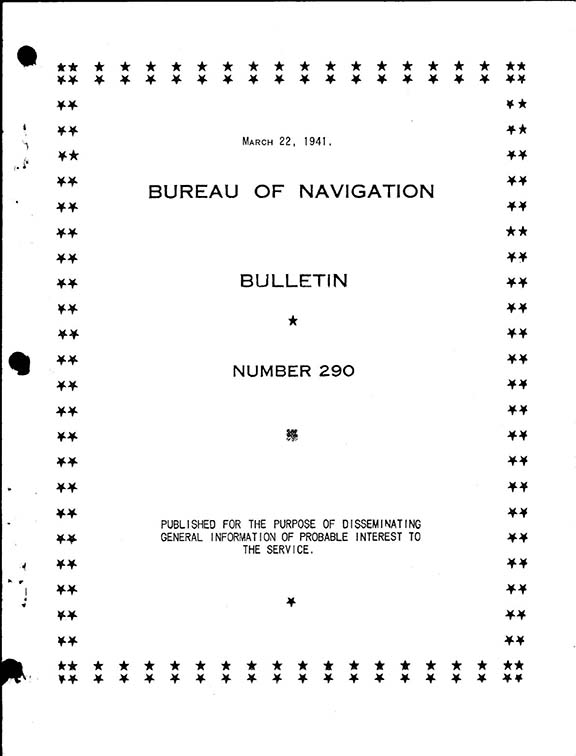 |
The dates of 16SEP41-20SEP41 are established for Warrant Officer Examinations. |
| May, 1941 | 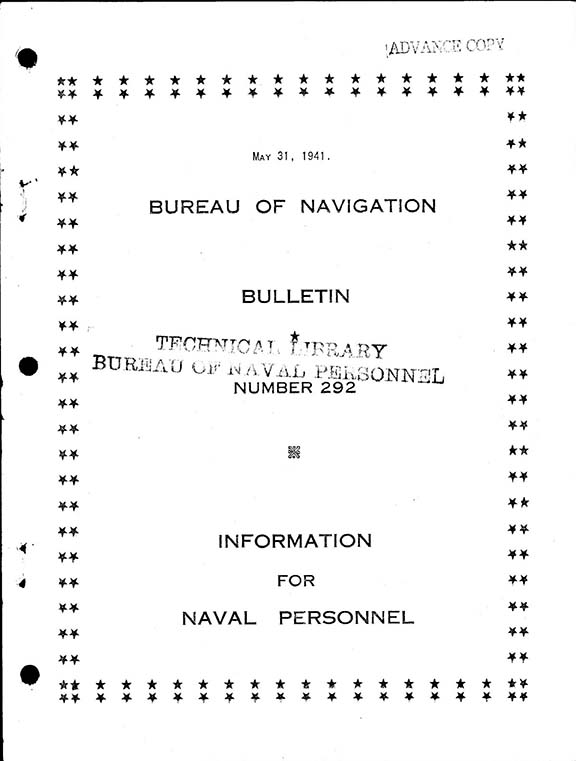 |
A list of enlisted men was issued acting appointments as warrant officer in the navy (Boatswains, Gunners, Machinists, and Carpenters). A garrison cap has been authorized for wear by commissioned and warrant Naval Aviators. |
| July, 1941 | 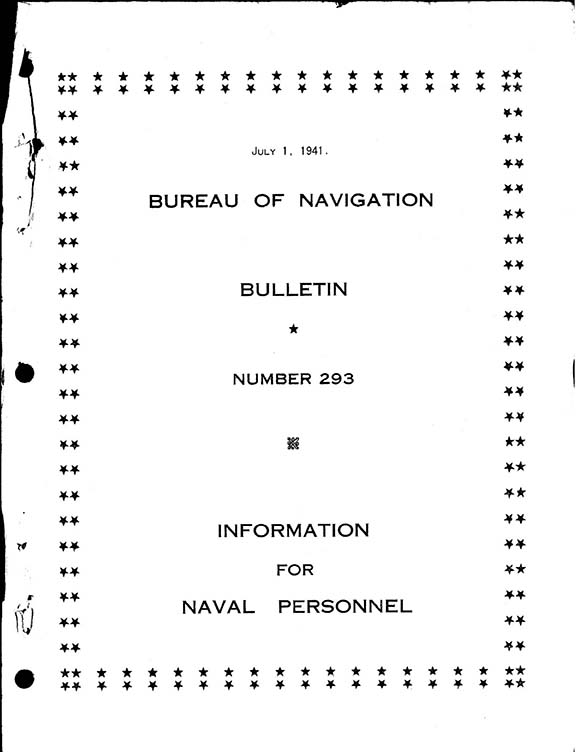 |
Navy announced acting appointments for enlisted men to warrant (Carpenters, Gunners, Machinists, Boatswains, and Electricians). Warrant Officer manpower is 1,998; an additional 82 retired warrants were recalled for active duty and 99 reserve warrants on active duty. |
| September, 1941 | 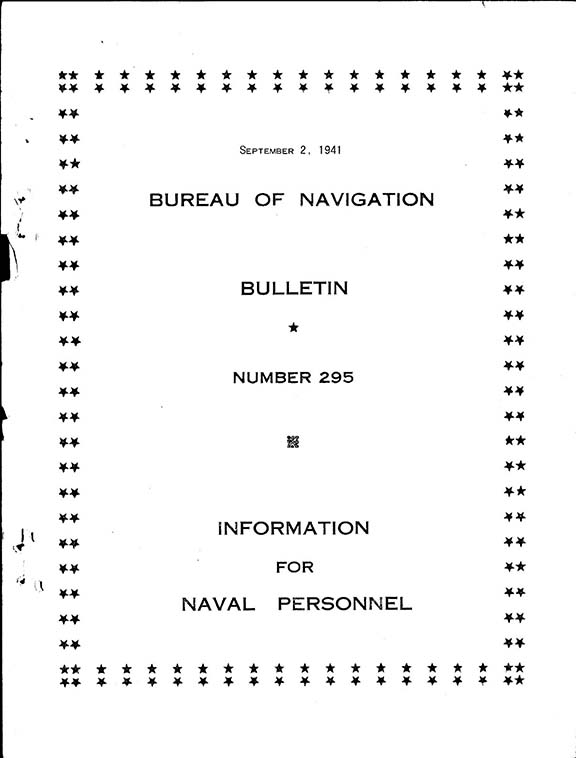 |
Enlisted men issued acting appointments as warrant officers in the Navy (Radio Electricians, Machinists, Carpenters, Electrician, and Gunner). |
| October, 1941 | 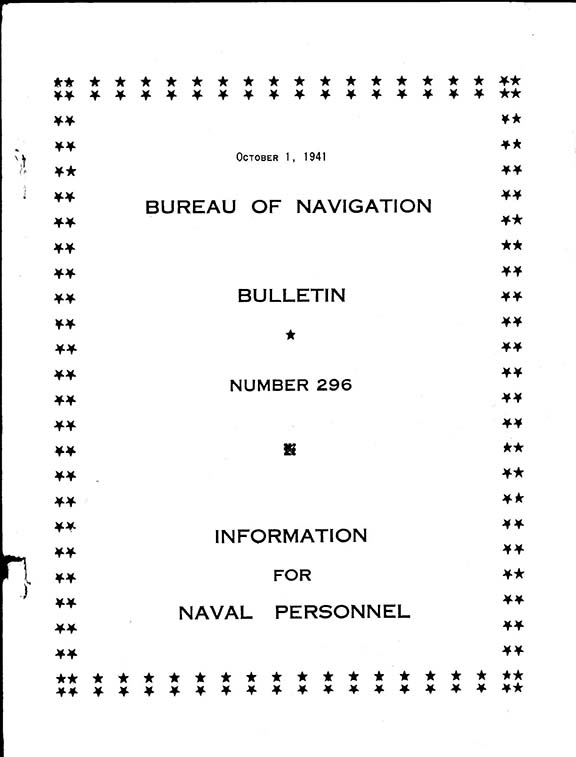 |
Navy announced acting appointments for enlisted men to warrant (Boatswain, Carpenters, Electricians, Gunners, & Machinists). The President approved a total of 228 US Marine Corps Chief Warrant and Warrant Officers be distributed as follows: Chief Marine Gunner and Marine Guner-138, Chief Quartermaster Clerk and Quartermaster Clerk-93, and Chief Pay Clerk and Pay Clerk-57. |
| November, 1941 | 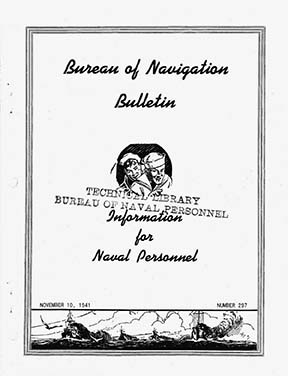 |
The names of warrant and commissioned warrant officers designated as qualified for temporary appointment to higher grades or ranks shall be placed on appropriate promotion lists in accordance with their qualifications. Officers on such lists shall be eligible for temporary appointment not above the rank for which designated. A 28 page list was release of Chief Warrant Officers recommended for Lieutenant, CWOs to O-2, CWOs to O-1, and enlisted men to CWO and WO. |
| December, 1941 | 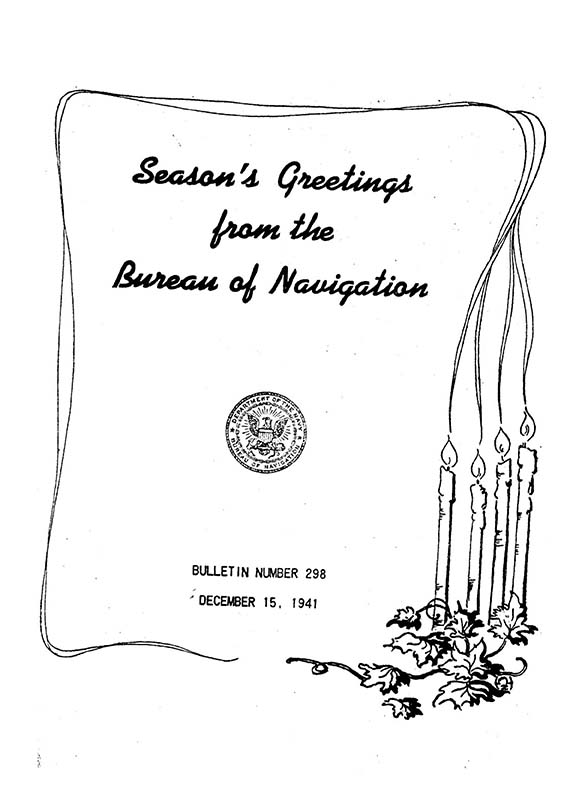 |
A list of enlisted men was issued temporary appointments as warrant officer in the navy (Boatswains, Gunners, Electricians, Radio Electricians, Machinists, Carpenters, Pharmacists, and Pay Clerks). |
| March, 1942 | 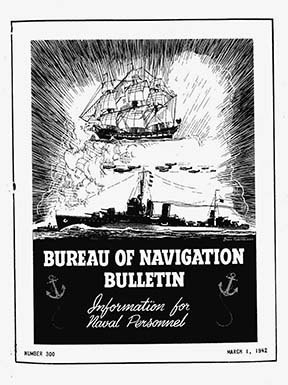 |
A Warrant Officer Machinist and Carpenter were of 6 people awarded Commendations for seizing the German Motor Ship ODENWALD on 06NOV41. A Chief Electrician’s Mate was temporarily advanced to the warrant rank of Electrician for “especially meritorious conduct in action” when the USS SALINA, a naval tanker, was torpedoed on 30OCT41. A poem on Page 47: Breathes there a chief |
| April, 1942 | 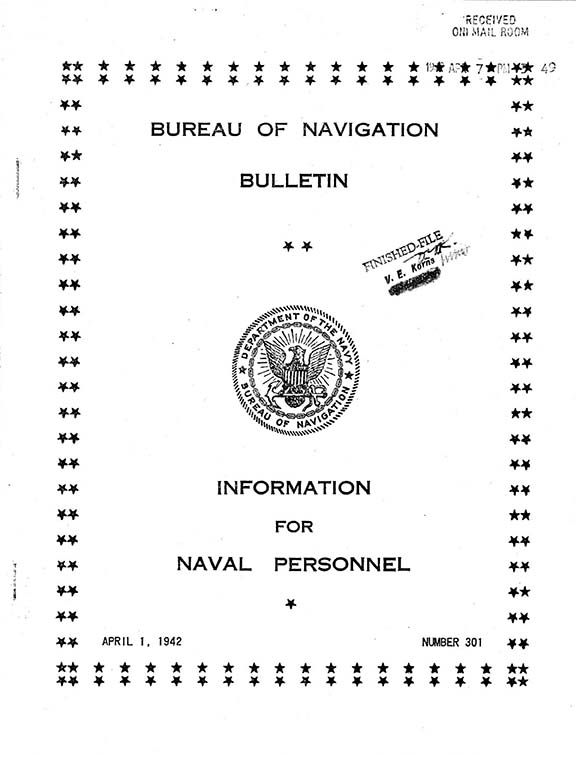 |
A Machinist, D. K. Ross, was the only survivor of the Japanese attack to win the Medal of Honor. When his station in the forward dynamo room became almost untenable due to smoke, steam, and heat, he forced his men to leave the station and performed all duties himself until blinded and unconscious. Twice he was rescued and resuscitated, and twice he returned to his station. On December 8, on his own initiative, he established a boat repair station, reclaimed and repaired abandoned boats, organized boat crews and made available many needed boats which otherwise would have been lost. A Chief Warrant Officer Boatswain, Edwin J. Hill, and Radioman, Thomas J. Reeves, also received the Medal of Honor. Both were deceased. A Warrant Officer Gunner was awarded the Navy Cross. A Chief Warrant Officer Boatswain, Lewis W. Adkins, and Electrician, R. W. Miller, were awarded Commendations from the Commander in Chief, U.S. Pacific Fleet. A Warrant Officer Pay Clerk, H. A. Applegate, was awarded Commendation from the Commander in Chief, U.S. Pacific Fleet. The Navy Cross was awarded to Chief Warrant Officer Pay Clerk, Othelo C. Brunn, and Boatswain, James C. Oster. The Navy Cross was awarded to Warrant Officer Pay Clerks John H. Walker and Clifford A. Hanson. Warrant Officer Machinist, Furman D. Waltrip, and Carpenter, Abner L. Alton, were commended by Vice Admiral Ingersoll and Rear Admiral Jacobs for capture of German ship that was disguised as a US ship. |
| June, 1942 | 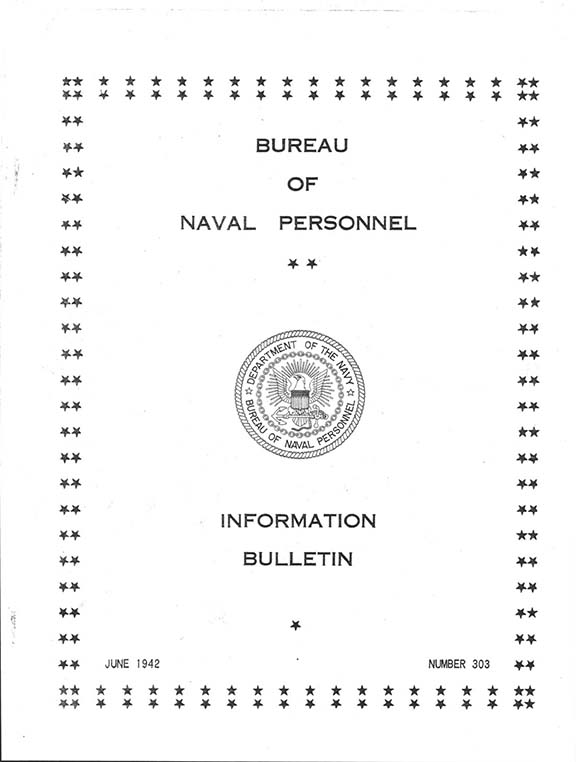 |
Various CWOs, WOs, and other Sailors were mentioned for stepping forward to act as nurse when Marblehead shared in battle. CWO Boatsain, Harold Johnson, received the Navy Cross for heroic conduct under fire and for distinguished service in line of his profession on USS HERON. |
| July, 1942 | 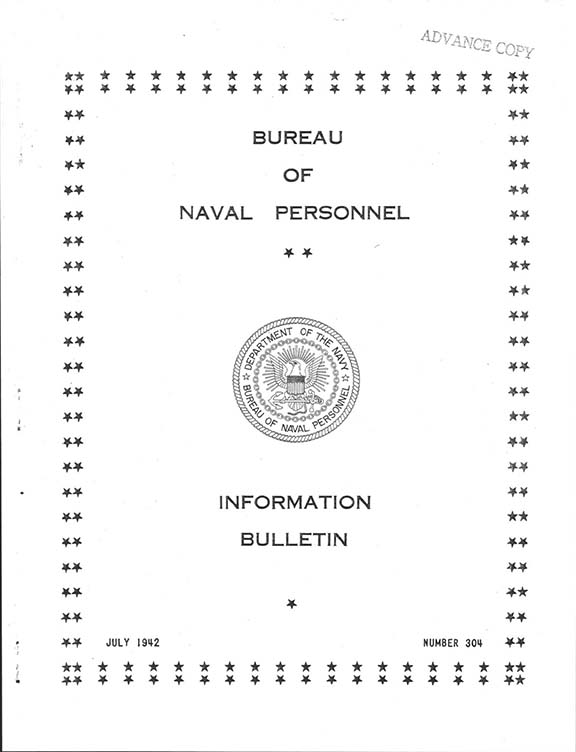 |
Warrant Officer Gunner, Harley E. Talkington, was awarded the Distinguished Flying Cross. Chief Warrant Officer Boatswain, William Harold Johnson, was awarded the Navy Cross for returning to his battle station as captain of an anti-aircraft gun crew after a bomb explosion hurled him from the gun platform to the main deck below. A Warrant Officer Boatswain, Adolph M. Borthne, was awarded the Navy Cross for acting as coxswain and picking up two boatloads of survivors after USS OKLAHOMA capsized. An Officer Pay Table shows four “pay periods” for Warrant Officer. The fourth annual Chief Warrant Officer Pay Period (base) is equal to an O-4 with less than 23 years of service. |
| August, 1942 | 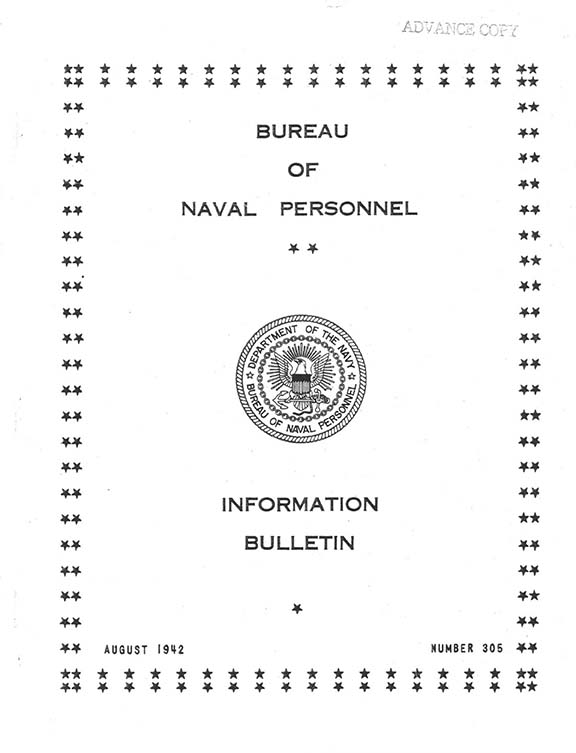 |
Chief Warrant Officer Boatswain, Edwin J. Hill (deceased), has been awarded the Congressional Medal of Honor. Warrant Officer Machinist, Donald K. Ross, has been awarded the Congressional Medal of Honor. A bunch of WOs and CWOs awarded the Navy Cross. Warrant Officer Gunner, awarded the Distinguished Flying Cross. Public Law 631 authorized the appointment of commissioned warrant and warrant officers to commissioned rank in the line and staff corps of the Navy, Marine Corps, and Coast Guard. Public Law 682 established the commissioned warrant grades of Chief Ship’s Clerk, Chief Aerographer, Chief Photographer, and Chief Torpedoman. In addition the non-commissioned warrant grades of Ship’s Clerk, Aerographer, Photographer, and Torpedoman were established. The names of new escort vessel released, 2 were named after CWOs (Boatswain Edwin Joseph Hill & Gunner Cornelius Cronin). A poem on page 64: ‘THE GUNNER” If I must be a Gunner, |
| September, 1942 | 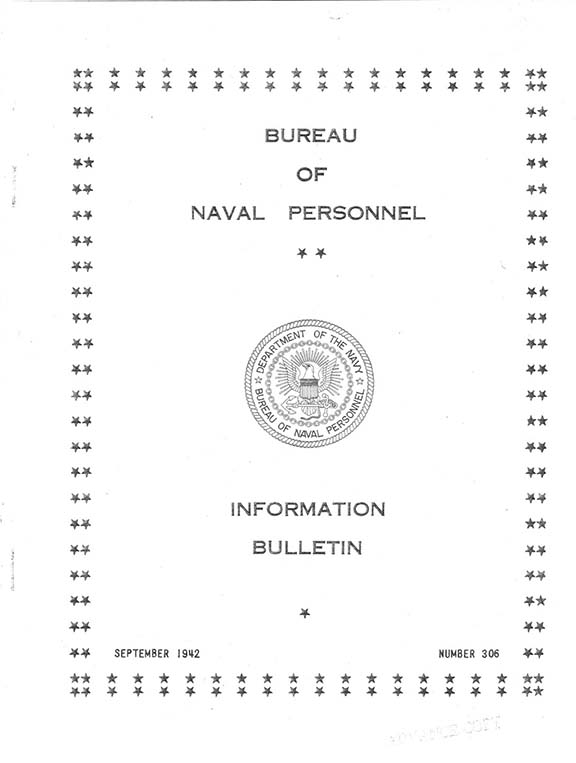 |
The Navy Cross was awarded to Donald C. Taylor, and he was promoted from the warrant grade of Gunner to Ensign. James Howard Steele, Chief Machinist’s Mate, USN, was awarded the Silver Star and advanced to the warrant grade of Machinist. Nicholas George Cucinello, Chief Water Tender, USN, was given the Silver Star and advanced to the warrant grade of Machinist. George William Head, Chief Pharmacist’s Mate, USN, recieved the Silver Star and advanced to the warrant grade of Pharmacist. Two Warrant Officers were Commended (Gunner Irvin F. English & Boatswain Bernice C. Hart) for courageous service in defense of Bataan Peninsula, both are listed as missing in action. |
| October, 1942 | 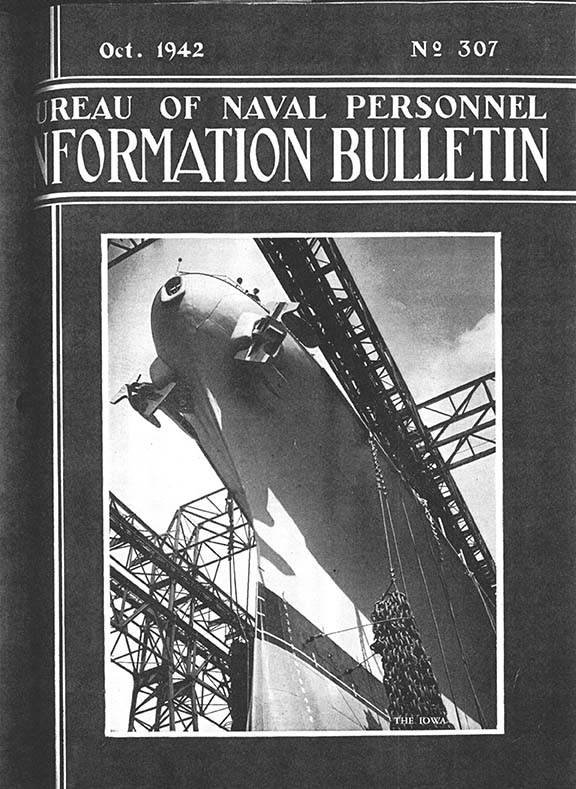 |
Warrant Officer Boatswain Adolph M. Bothne, USN, was awarded the new Navy and marine Corps Medal for entering a compartment where four men had suffocated saving one man before he himself was overcome. A warrant officer was captured at Corregidor. A poem on Page 33. 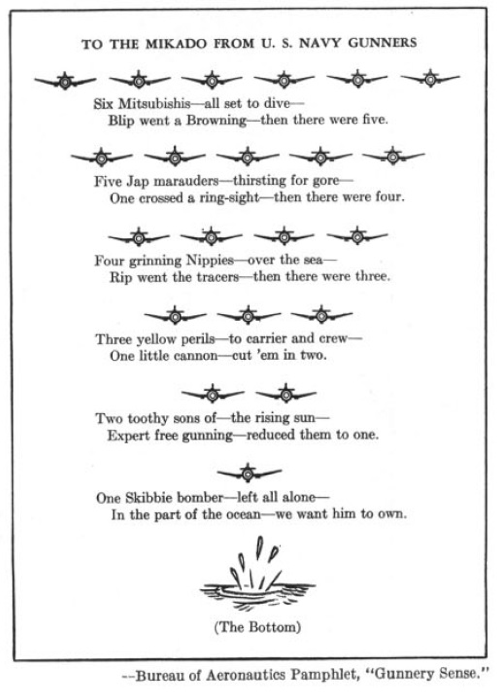 |
| November, 1942 | 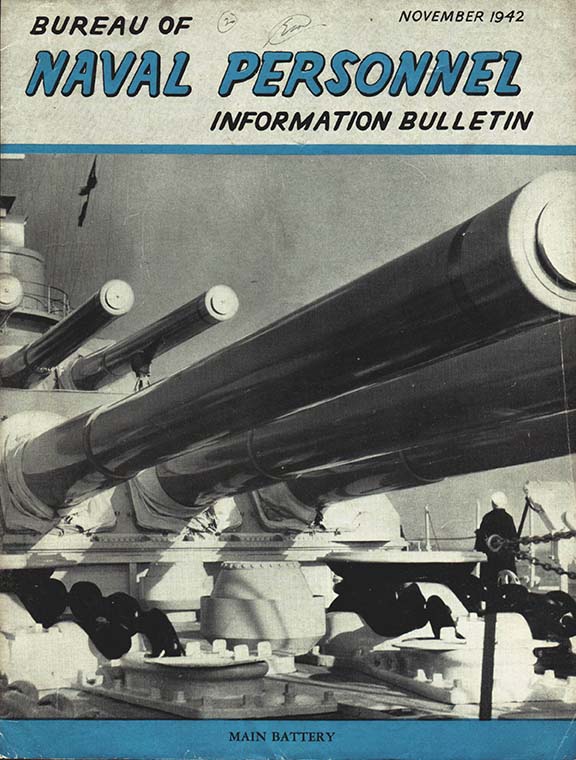 |
Warrant Officer Gunner, C. A. Carlson, awarded the Purple Heart for wounds received in action in Bataan Province, P. I. |
| December, 1942 | 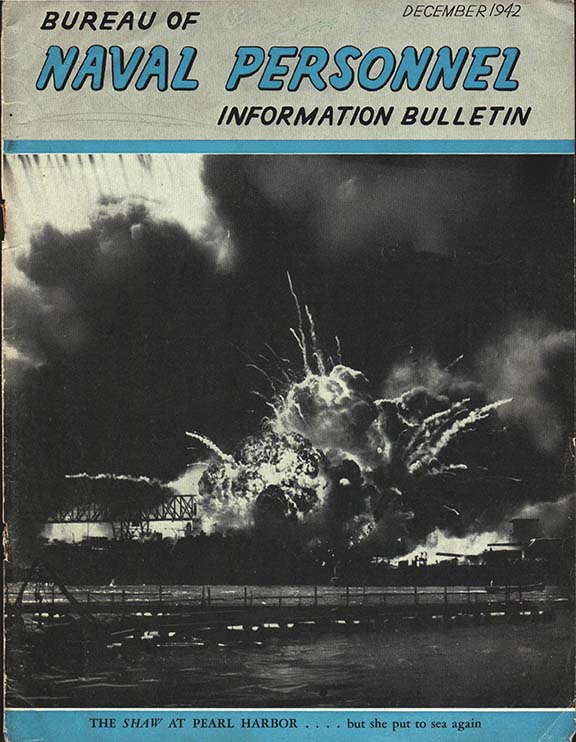 |
Retired explained: By law, commissioned and warrant officers on the retired list of the Navy on active duty are temporarily appointed to higher ranks or grades on the retired list. A bunch of Warrant Officers and Chief Warrant Officers received, along with many others, the Navy Cross, the Distinguished Flying Cross, and the Navy and Marine Corps Medal. |
| January, 1943 | 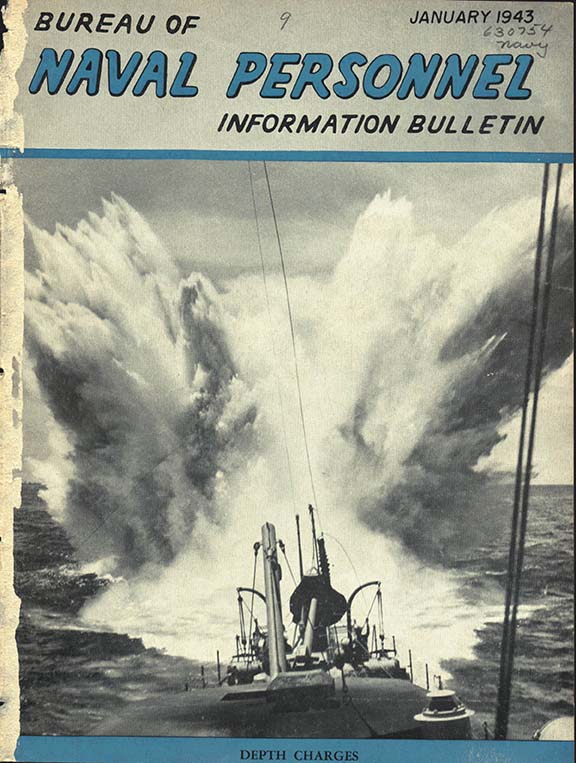 |
Promotions to the ranks of ensign to lieutenant in the Naval Reserve inclusive may now be made in the case of permanent commissioned warrant officers and warrant officers serving as such of the Naval Reserve who have served on continuous active duty such for 6 months, and who are in all respects qualified to perform duties in higher temporary ranks and grades at sea in general service classifications, according to Allnav 265, December 8, 1942. Two warrant officers were commended for meritorious service aboard the U.S.S. Yorktown during the Battle of Midway. |
| February, 1943 | 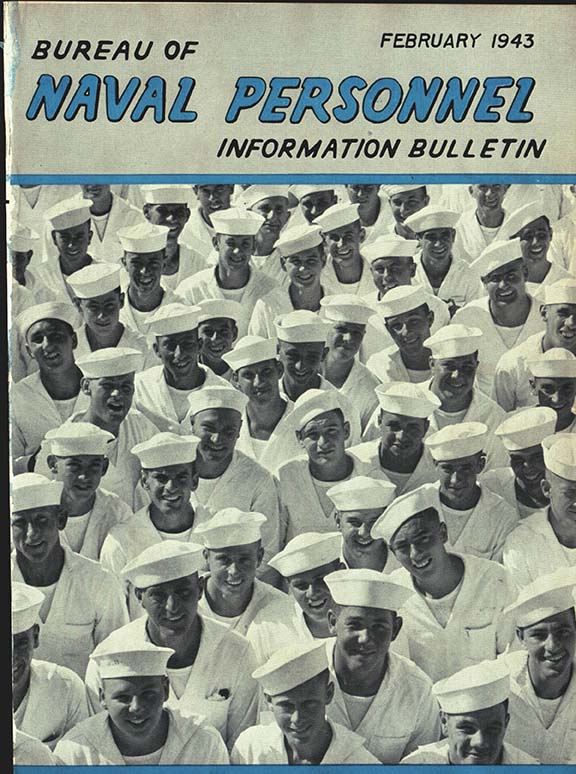 |
A story of Hospital Corpsman states that warrant grades of Pharmacist was created 17JUN1898. In 1912, the commissioned warrant grade of Chief Pharmacist was created. All newly appointed warrant officers are directed to submit a form (data cards) immediately on acceptance of appointment. This forms provides a handy background of the officer’s duties and qualifications. A bunch of warrant officers and chief warrant officers were awarded various medals and commendations. |
| March, 1943 | 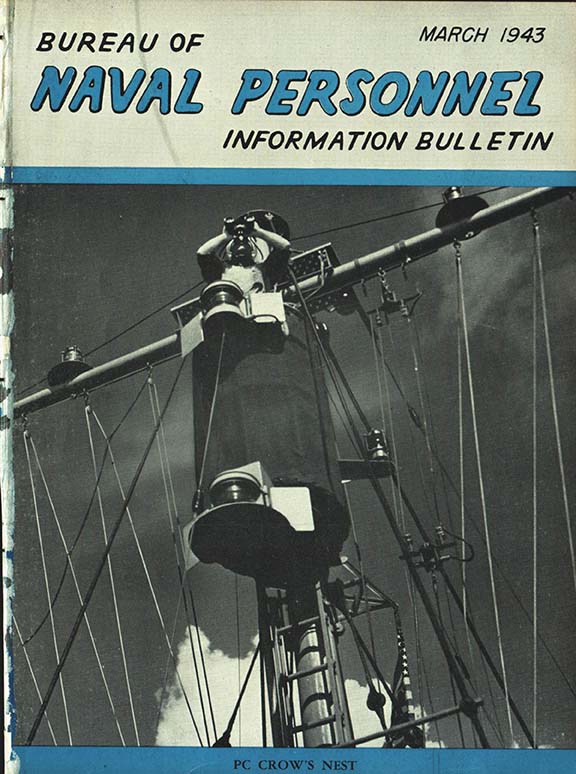 |
Warrant Officer James D. Fox survived 112 bombings and being under shellfire 30 times int eh 90 days he was on Guadalcanal, a Coast Guard ship. Vardie Taylor was promoted to the warrant rank of gunner, for his cool and studied actions while handling ordnance during a fire and his conduct under fire during the Battle of Midway. Navy is soliciting warrant officers and chief warrant officers for dive school. A bunch of warrant officers and chief warrant officers were awarded various medals and commendations. |
| April, 1943 | 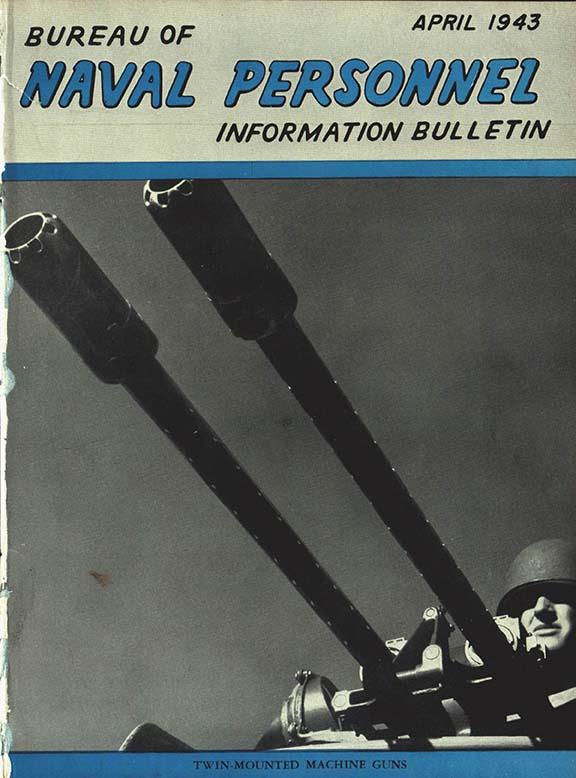 |
Two Dutch Seamen and Navy Gunner pull through after 83 days on a life raft off the Brazilian coast. A bunch of warrant officers and chief warrant officers were awarded various medals and commendations. |
| May, 1943 | 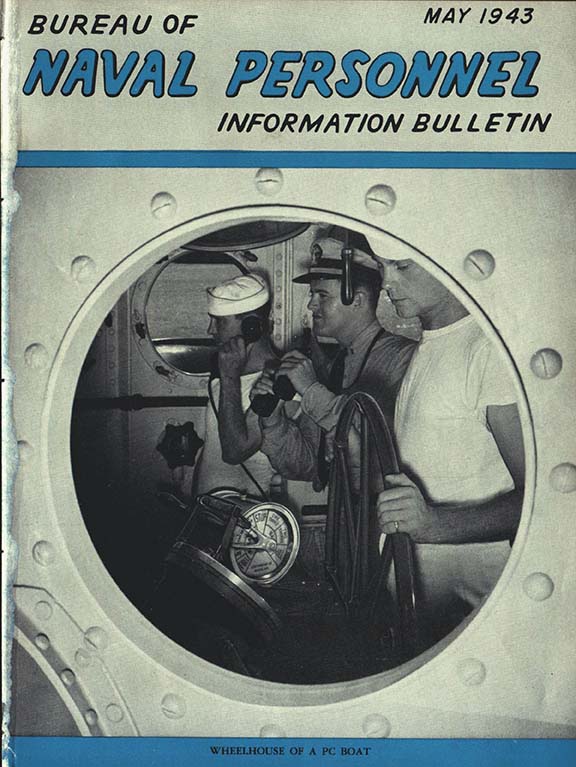 |
Authorized classifications for warrant officer of the U.S. Naval Reserve are identified. A picture shows officer hierarchy and warrant specialties. CWOs rank above midshipmen and WOs rank below midshipmen. A detailed chart shows the normal path of advancement from Apprentice Seaman to Warrants. A bunch of warrant officers and chief warrant officers were awarded various medals and commendations. |
| June - October, 1943 | A bunch of warrant officers and chief warrant officers were awarded various medals and commendations. | |
| December, 1943 | 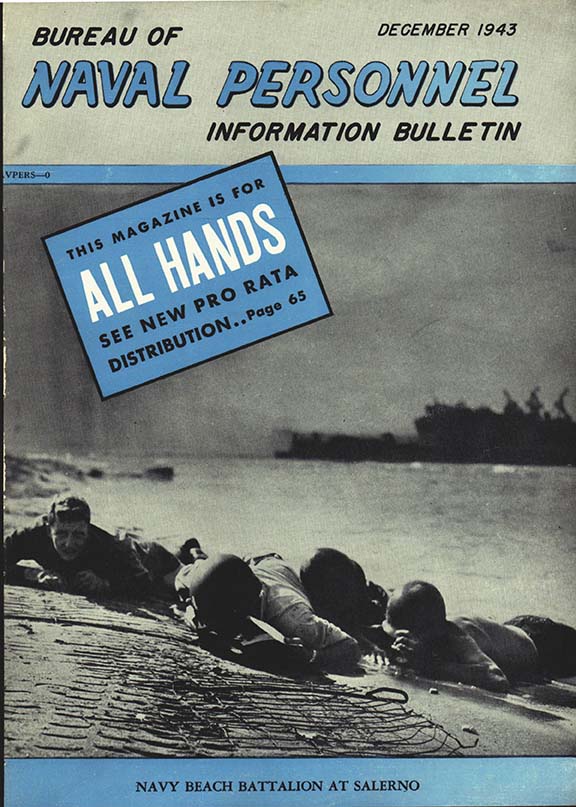 |
ALNAV No. 177 established warrant grades in the Marine Corps. Regarding gun salutes, the reason the Navy only uses odd number of guns is because it is considered lucky. In the olden days an even number of guns were fired when the captain or master gunner died during voyage. A bunch of warrant officers and chief warrant officers were awarded various medals and commendations. Chief Warrant Officer Boatswain, Edwin J. Hill, awarded the Medal of Honor. 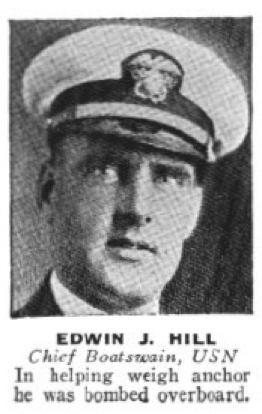 |
| January - April, 1944 |
A bunch of warrant officers and chief warrant officers were awarded various medals and commendations. |
|
| May, 1944 | 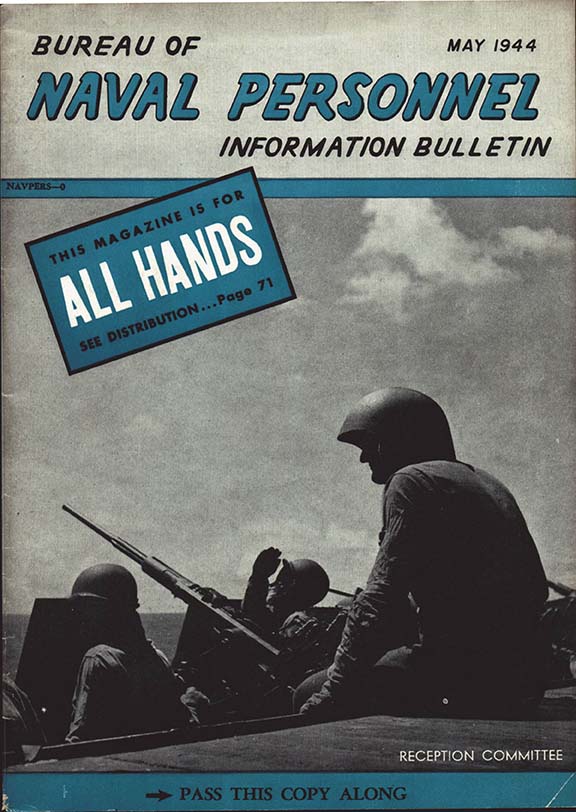 |
Warrant Officers are now promoted to Chief Warrant Officer by block system. At least 10 months in rank is required. Individual recommendations for promotion of warrant officers to chief warrant rank are no longer desired. |
| June, 1944 | 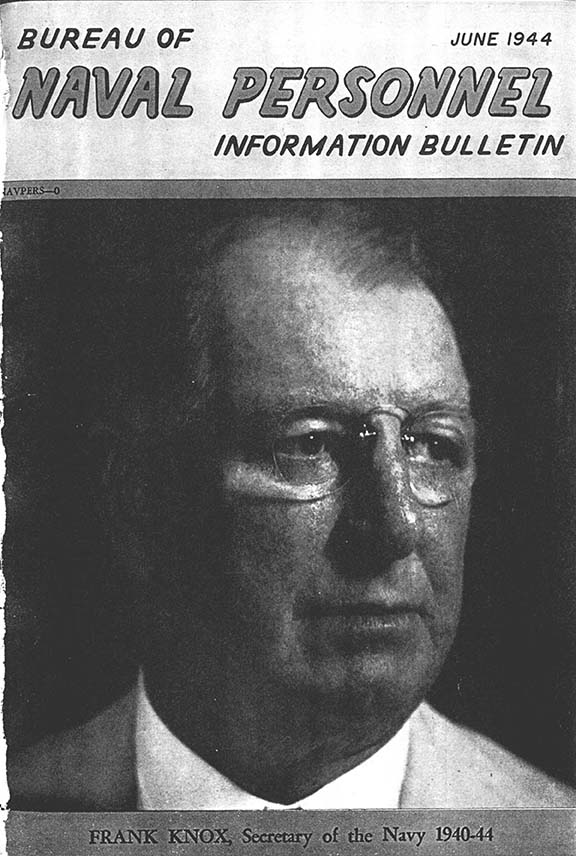 |
CWO commission and pay status was questioned and answered in the Q&A section. |
| July, 1944 | 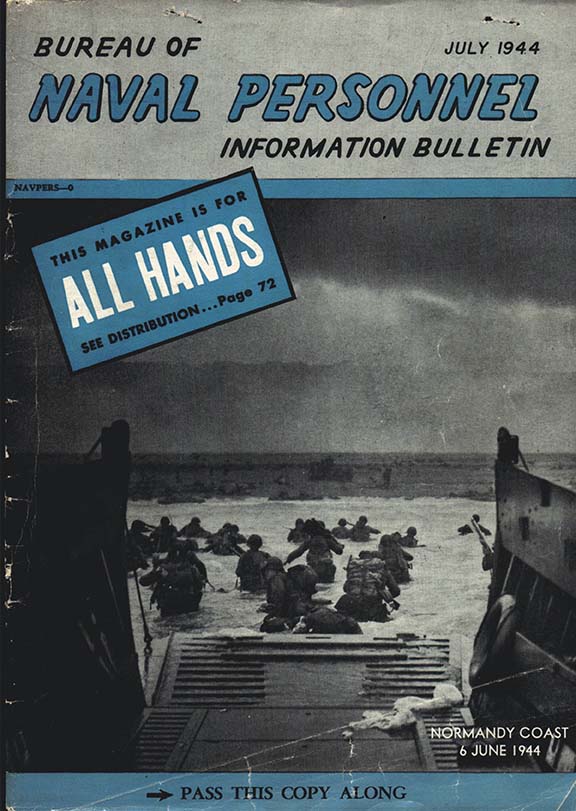 |
On the “What is Your Naval I.Q.?” section, a question asked if you could name the warrant grades in the naval service. Answer: Boatswain, Gunner, Torpedoman, Electrician, Radio Electrician, Machinist, Carpenter, Ship’s Clerk, Aerographer, Photographer, Pharmacist, Pay Clerk, and Acting Pay Clerk. A couple questions were asked in the “Letters to the Editor” section regarding warrants. The first question was in regards to sea requirements and PO1c qualifications for warrant eligibility. The answer was that COs are authorized to recommend any PO1c or CPO for temporary appointment to warrant grade or commissioned rank whenever they deem him qualified, there is no sea duty requirement for aviation ratings. A retired Chief Warrant Officer Boatswain asked about the block system for warrant officer promotion to chief warrant officer. It was answered that the minimum requirement is at least 12 months in warrant grade. A Warrant Officer Boatswain, Thomas C. Checik, awarded the Silver Star Medal for directing a battle against flames when his ship was attacked. |
| August, 1944 | 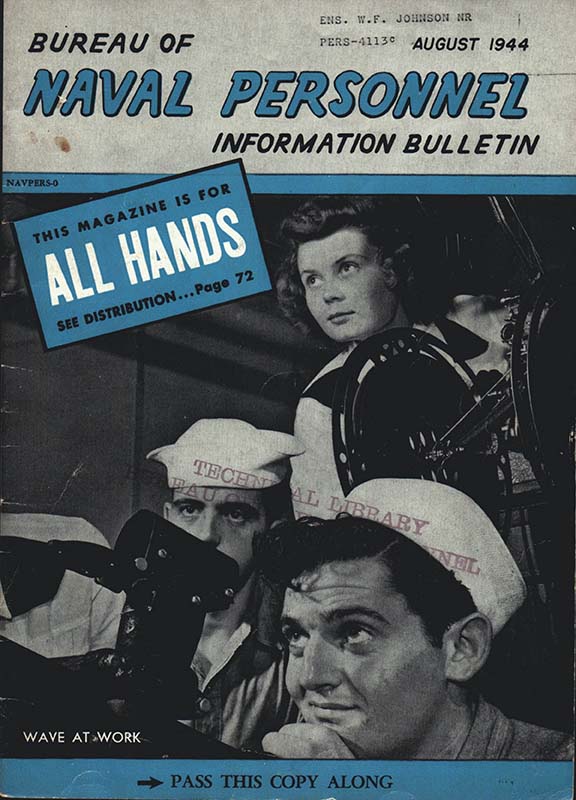 |
A chief warrant officer or warrant officer is never addressed as “chief.” He is always called “Mr. _____.” In the “Letters to the Editor” section, someone asked what insignia a warrant officer wears on his overseas cap. Some wear the fouled anchor on one side and the corps device on the other, some the corps device on both sides. The answer: warrant officers wear the corps device on both sides of the garrison cap. |
| September, 1944 | 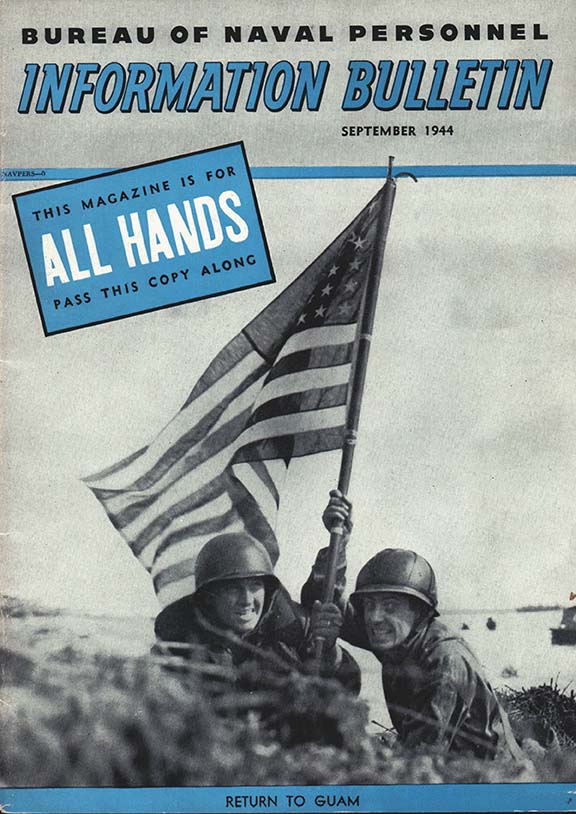 |
A Warrant Officer Carpenter, Pryor S. Bennett, was awarded the Navy and Marine Corps Medal for making dives in extraordinary conditions inside submerged vessels. A Warrant Officer Machinist, Judson G. Butland, was awarded the Navy and Marine Corps Medal for rescuing four men who stunned by shock when their plan came in contact with a high-tension wire. |
| October, 1944 | 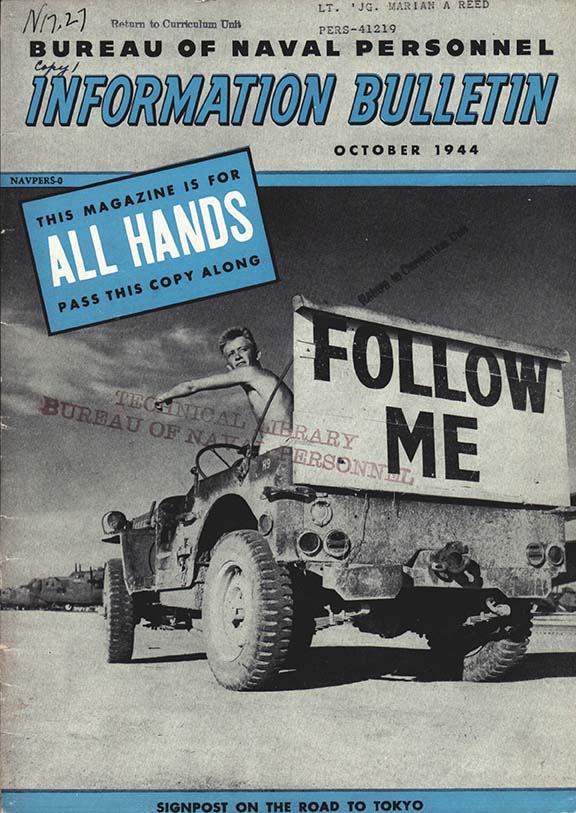 |
Warrant Officer Boatswain, Joseph V. Kaspar, awarded the Silver Star Medal while acting as coxswain of a landing craft delivering equipment under sniper fire and mortally wounded. A Chief Warrant Officer Machinist, Carl N. Sears, was awarded the Navy and Marine Corps Medal for giving his life in order to prevent his ship from flooding. A Warrant Officer Machinist, Wilbur J. Camblin, was awarded the Navy and Marine Corps Medal for saving a sailors life after he’d become trapped in a flooding compartment. This is one way to earn promotion to warrant: 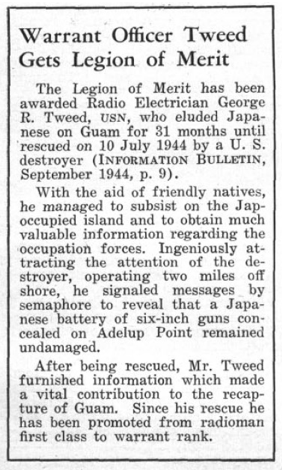 |
| November, 1944 | 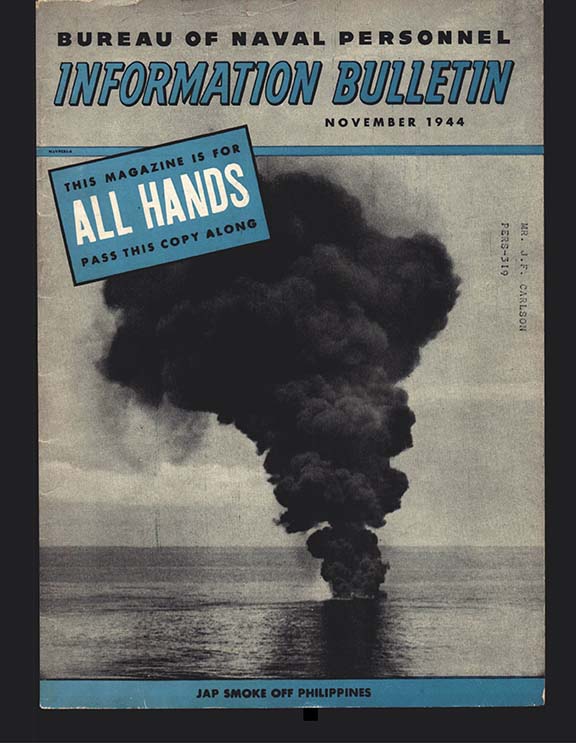 |
A gun from the old USS NEW ORLEANS, salvaged from a junk pile by Chief Warrant Officer Gunner Maurice Shea, USN, now decorates the west gate at Naval Repair Base, New Orleans, LA. Warrant Officer Boatswain, David A. Elder, awarded the Silver Star Medal for administering first aid bomb fragments and flying shrapnel wounded two men on the bridge. Chief Warrant Officer Carpenter, Henry H. Youngblood, awarded Navy and Marine Corps Medal for cutting away bulkheads that entrapped many men sustaining a major injury. Warrant Officer Boatswain, Henry H. Youngblood, awarded Navy and Marine Corps Medal for repeatedly diving into shark infested waters to find a dormant missile in order for it to be retrieved. Warrant Officer Machinist, John T. Strauss Jr, awarded Navy and Marine Corps Medal for carrying men overcome by fumes in a fire to safety. |
| December, 1944 | 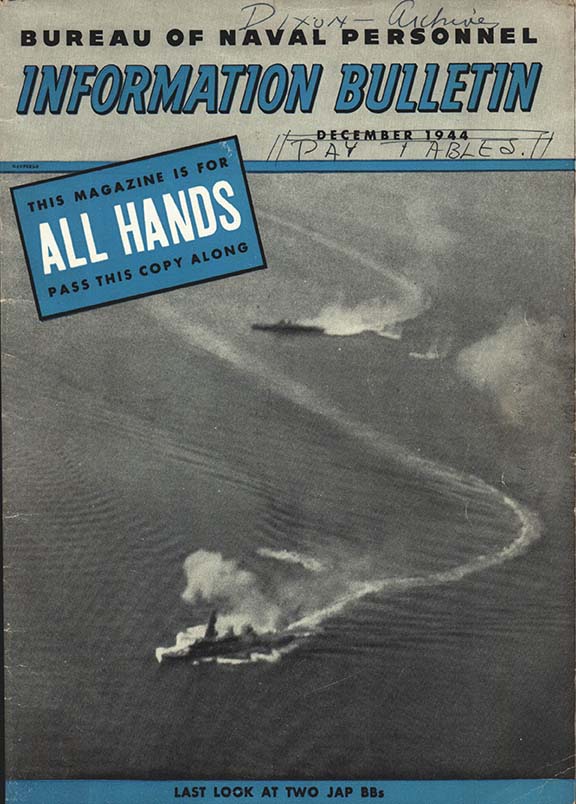 |
Retirement system for warrant officers and chief warrant officers is discussed in detail. A retirement pay table is shown. Chief Warrant Officer retirement pay is equivalent to O-3 retirement pay. A Chief Warrant Officer Gunner, Fay M. Lightner, was awarded the Legion of Merit for leading a team to fight off enemy planes assuming the role of gunnery officer after he was wounded and unconscious. Chief Warrant Officer Carpenter, Clarence M. Bailey, awarded Navy and Marine Corps Medal for helping to save a gun captain’s life after he was pinned from an explosion. Commissioned and non-commissioned Warrant Officer longevity increases: In the computation of service for longevity increases in pay, commissioned warrant officers shall be credited with full time (active and inactive) for all period during which they were enlisted or have held commissions as officers or have held appointments as warrant officers. |
| January, 1945 | 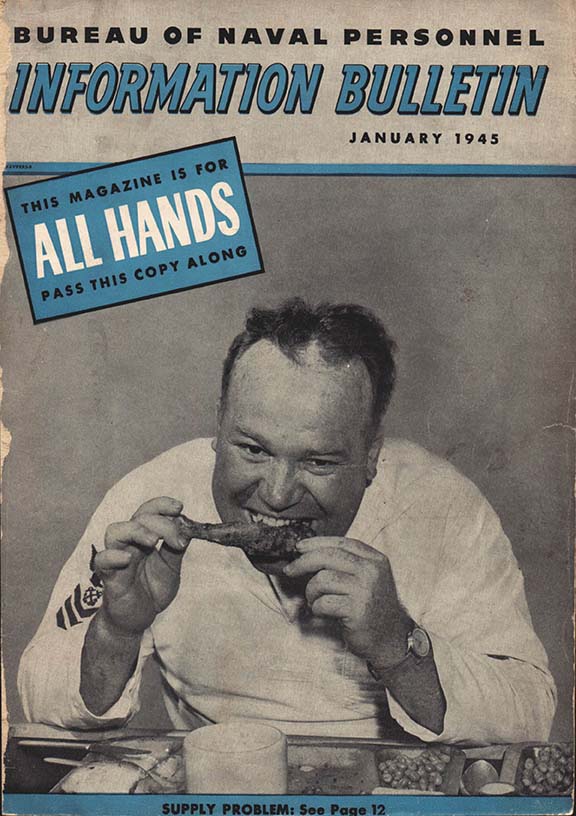 |
A Warrant Officer Gunner, Robert P. Burr, was awarded a Legion of Merit (posthumously) for reasons that cannot be revealed. A Warrant Officer Gunner, Robert P. Burr, was awarded a Legion of Merit (posthumously) for reasons that cannot be revealed. |
| February, 1945 | 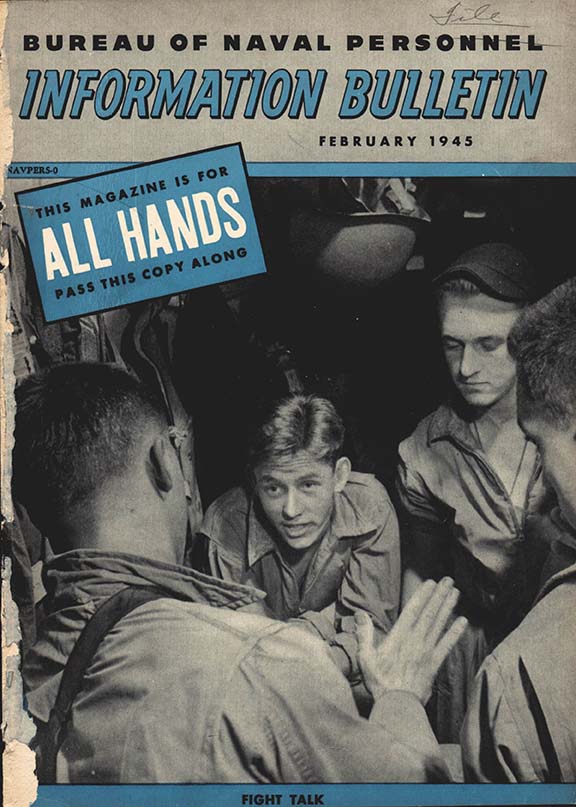 |
Officer programs are discussed and appointment requirements are defined for warrant officer and chief warrant officer. A Chief Warrant Officer Carpenter, William R. Wootten, was awarded the Navy and Marine Corps Medal for safely leading his crew and tugboat to the beach after attacked with three enemy bombs despite painful wounds. |
| April, 1945 | 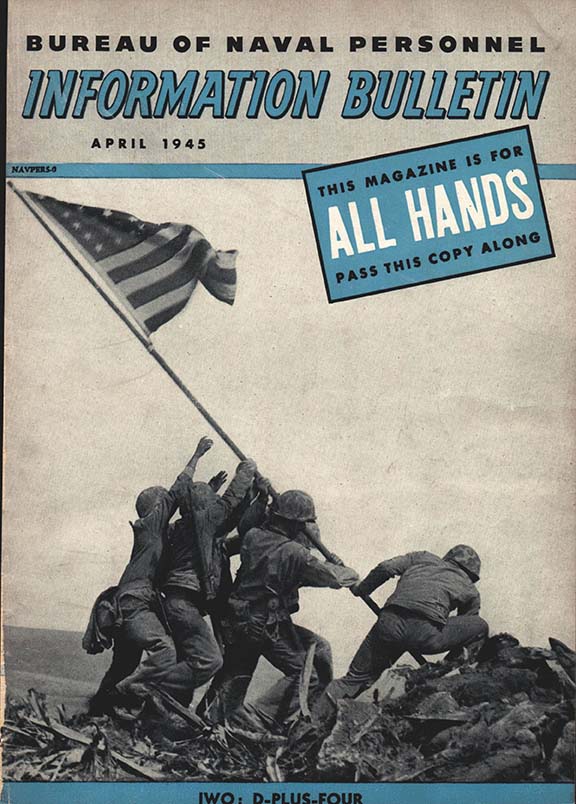 |
In the “Question and Answers’ section, a sailor asks if a warrant officer rates a salute. The answer, of course, was yes. A Warrant Officer Boatswain, Kurt R. Groote, was awarded the Silver Star Medal. A Warrant Officer Carpenter, Guy J. Fruzia, was awarded the Navy and Marine Corps Medal. A Chief Warrant Officer Machinist, William R. Ziel, a Warrant Officer Torpedoman, Emil A. Gaetana, Warrant Officer Machinist, Augustus E. Terry, and a Warrant Officer Boatswain, Charles E. Wilber, were awarded the Bronze Star Medal. In the “What is Your Naval I.Q?” section, the follow answer was given to warrant question: CWOs/WOs Pharmacist and Pay Clerk are classified as staff officers. |
| May, 1945 | 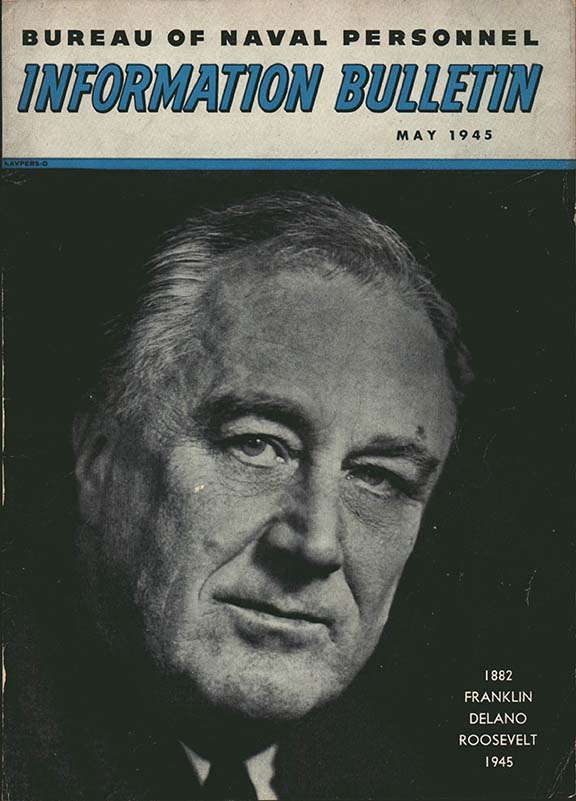 |
Warrant Officer Gunner, Albert C. Hoetzel, awarded Silver Star Medal (posthumously). |
| June, 1945 | 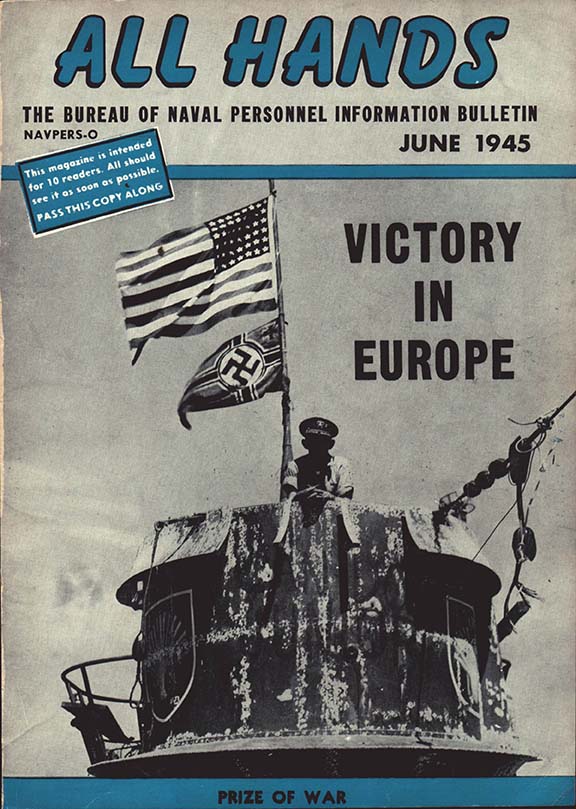 |
Warrant Officer Boatswain, John P. Colhan, awarded Bronze Star Medal. |
| July, 1945 | 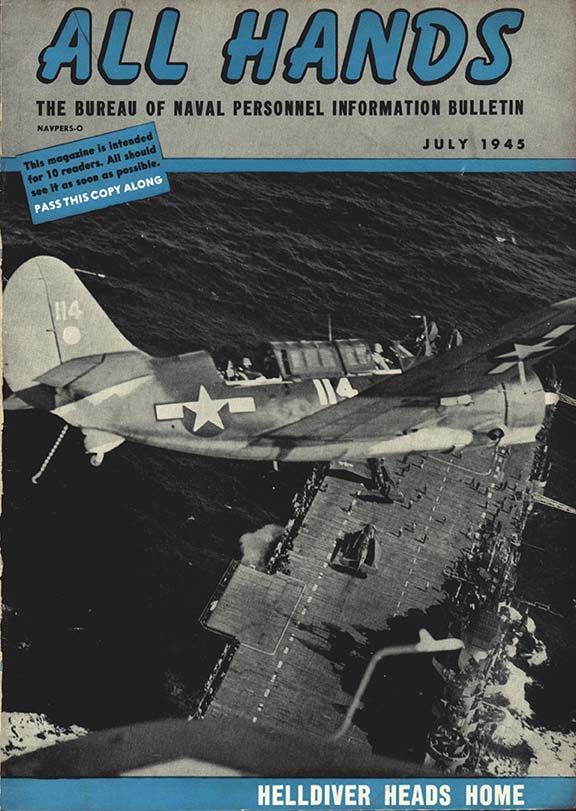 |
Warrant Officer Pharmacist, N. Y. Highland, awarded the Bronze Star for as member of the crew aboard a submarine. Navy promoted 523 active duty sailors to Commissioned Warrant Officer. Navy promoted 307 reserve sailors to Commissioned Warrant Officer. |
| August, 1945 | 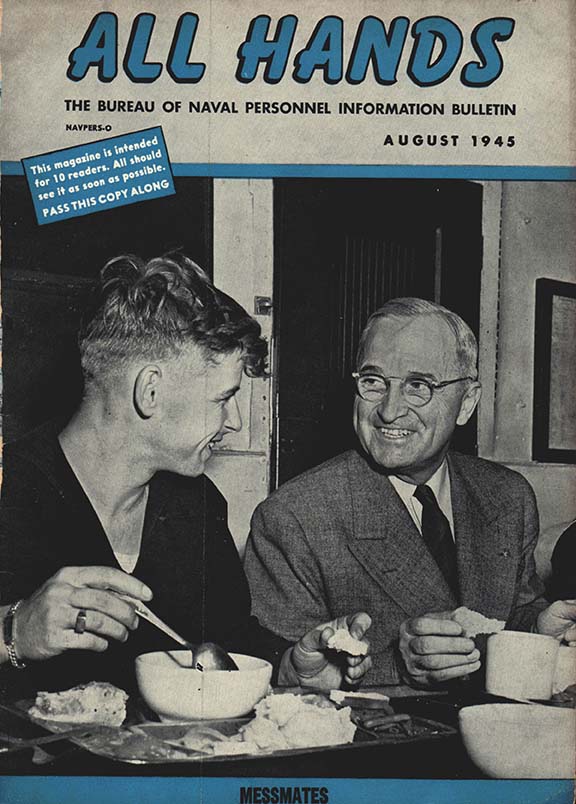 |
Regarding the garrison cap, Chief Warrant Officers wore the miniature commissioned officers cap device on the left side and the corps device, in silver, on the right side. Warrant Officer Machinist, William E. Green Jr. & Walter E. Macomber, awarded the Silver Star Medal. Warrant Officer Carpenter Lewis R. Eddins, Electrician Elmer C. Phillips, Gunner Roy G. Gale, and Gunner Walter S. Hatcher Sr, awarded the Bronze Star Medal. Warrant Officer Electrician, Lewis R. Baker, and Machinist, Marley O. Polk, awarded the Navy Cross. |
| October, 1945 | 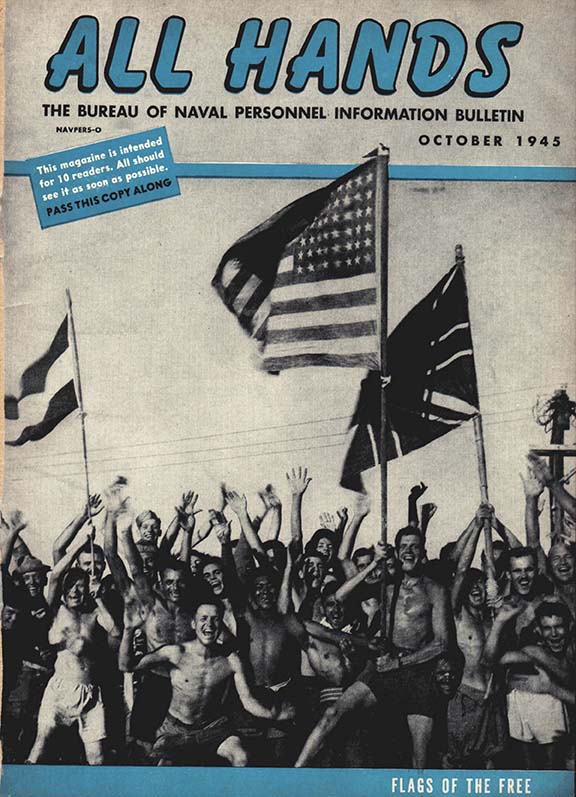 |
Warrant Officer Gunner, Robert P. Burr, awarded the Legion of Merit. 470 active duty sailors promoted to Chief Warrant Officer. 121 reserve sailors promoted to Chief Warrant Officer. |
| February, 1946 | 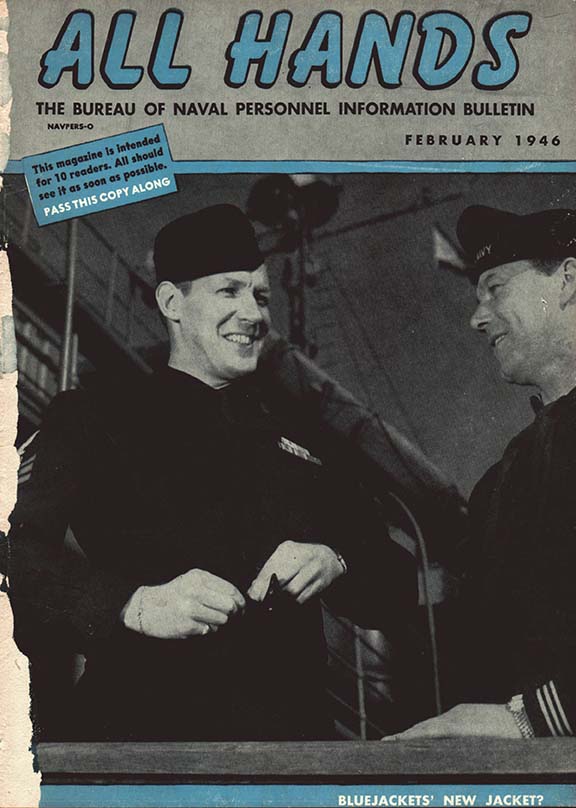 |
412 active duty sailors promoted to Chief Warrant Officer. 221 reserve sailors promoted to Chief Warrant Officer. |
| June, 1946 | 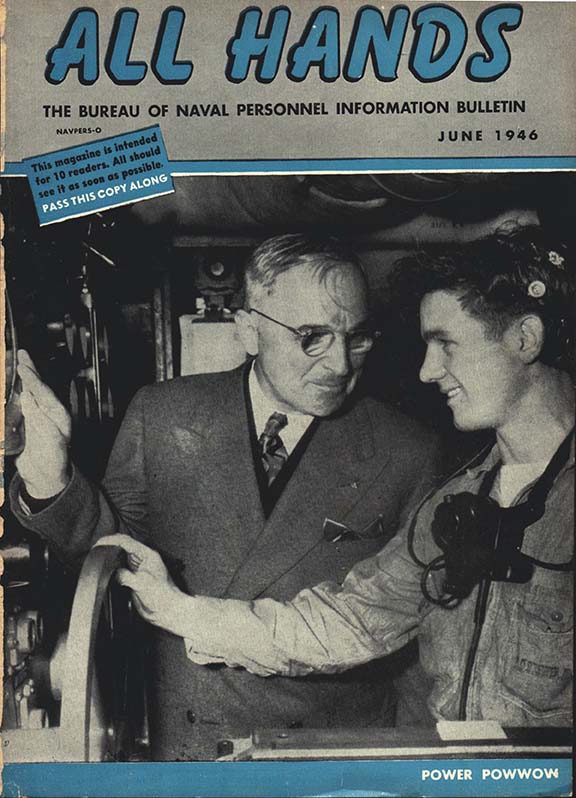 |
Warrant rank revision consideration to create a warrant rank for each enlisted rating. A Warrant Officer Gunner, Charles E. Gulliams, awarded the Bronze Star Medal as Assistant Torpedo Data Computer Operator on USS Tautog. A chart shows the retired pay for commissioned and warrant officers. |
| July, 1946 | 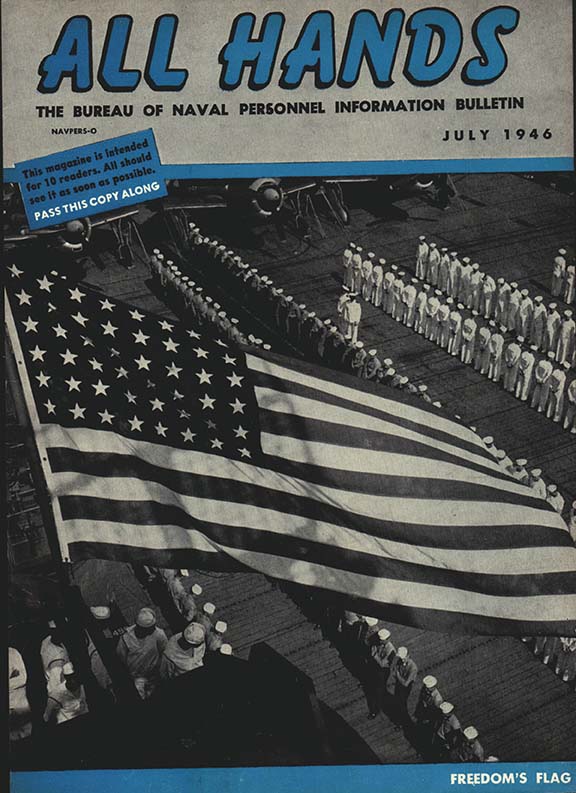 |
In the Battin’ The Breeze section, the article “Plane Salty” tells the story of a salty Warrant Officer Radioman. Chief Warrant Officer Pay Clerk, Othello C. Brunn, awarded the Navy Cross (posthumously) for saving supplies and currency during the Japanese bombardment of the Philippines, being captured and held on a prison ship, and dying when the ship was bombed. Warrant Officer Gunner, Le Roy L. Hoyt & Lee G. Millis, awarded the Silver Star Medal. Warrant Officer Gunner, James E. Hogan, awarded the Bronze Star Medal. |
| August, 1946 | 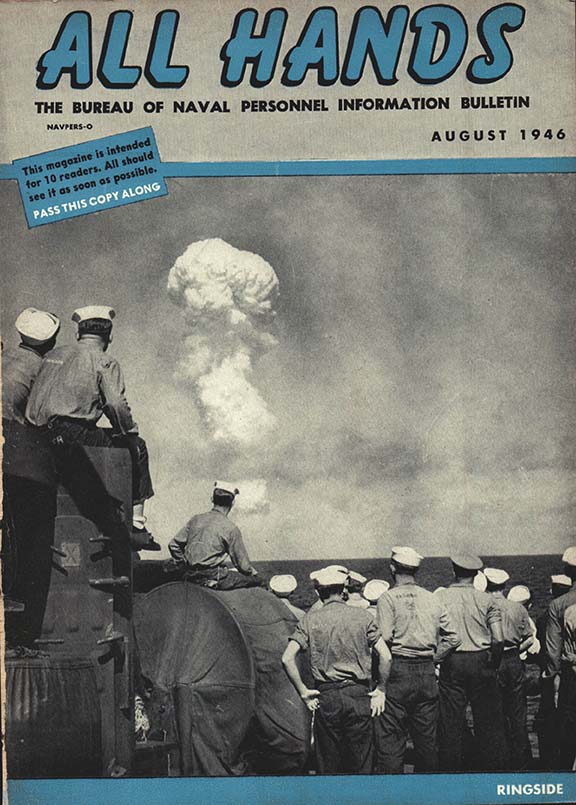 |
Warrant Officer Gunner, William J. Burton, awarded the Bronze Star Medal (posthumously). |
| September, 1946 | 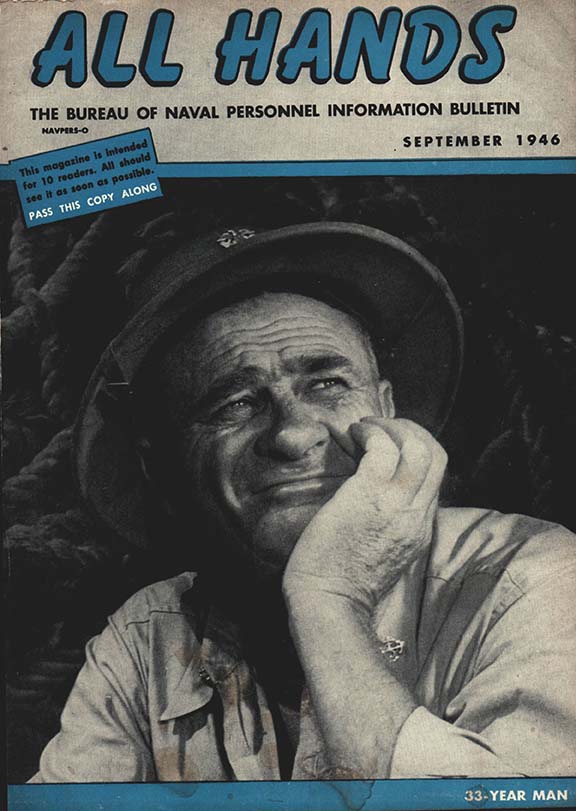 |
The issue of traning courses and warrants was addressed. |
| October, 1946 | 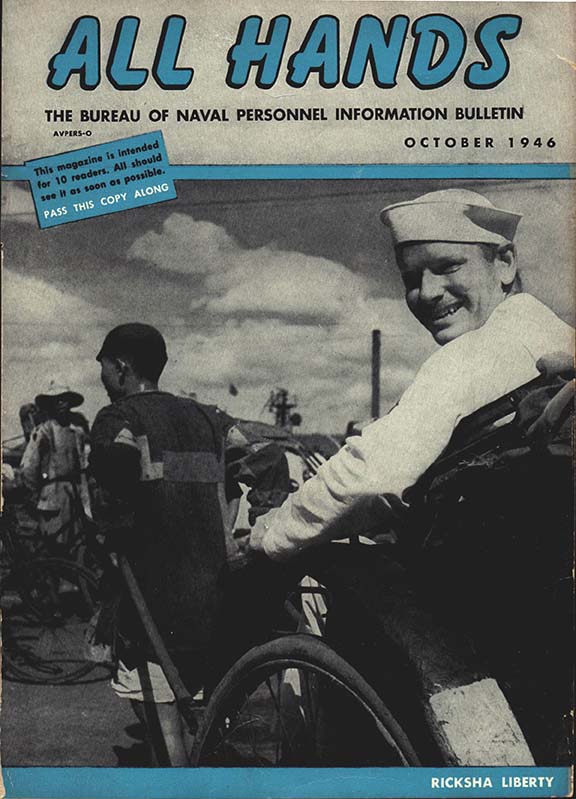 |
Warrant Officer Pharmacist, Edward F. Haase, awarded Bronze Star Medal. |
| November, 1946 | 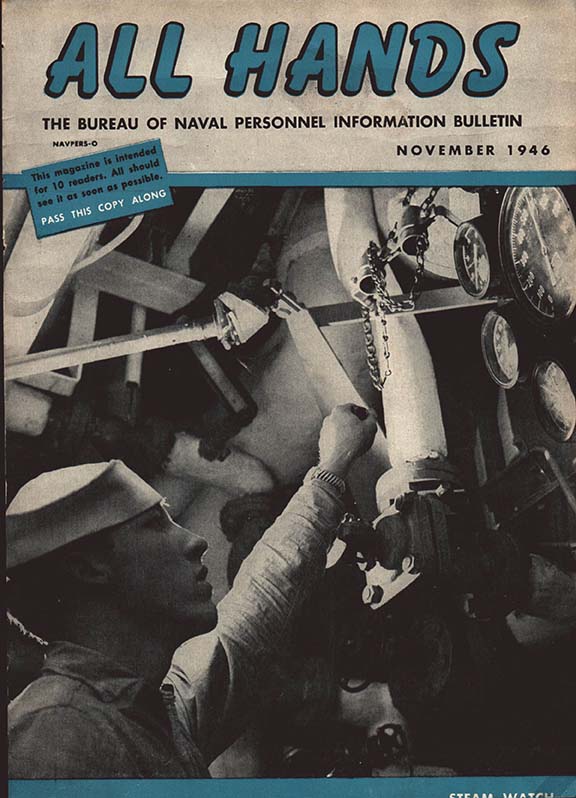 |
Warrant Officer Gunner, Robert. B. Willhoite, awarded Silver Star Medal. Warrant Officer Gunner, Carl A. Carlson Jr. & Rudolph Nikkonen, awarded the Bronze Star Medal. |
| January, 1947 | 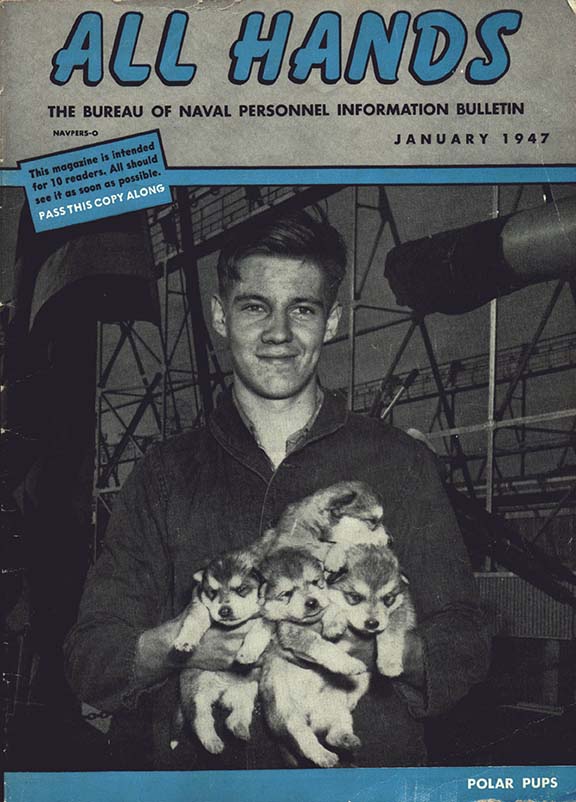 |
Warrant Officer Gunner, Leif T. King, awarded the Navy and Marine Corps Medal. |
| February, 1947 | 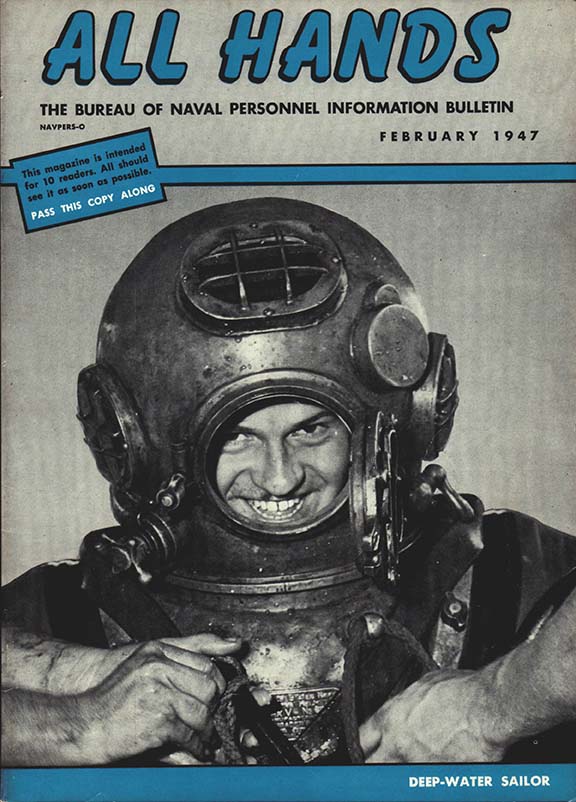 |
Chief Warrant Officer Boatswain, Joseph A. McGrane, awarded the Silver Star Medal. Warrant Officer Boatswain, James L. Utz, awarded the Silver Star Medal. |
| March, 1947 | 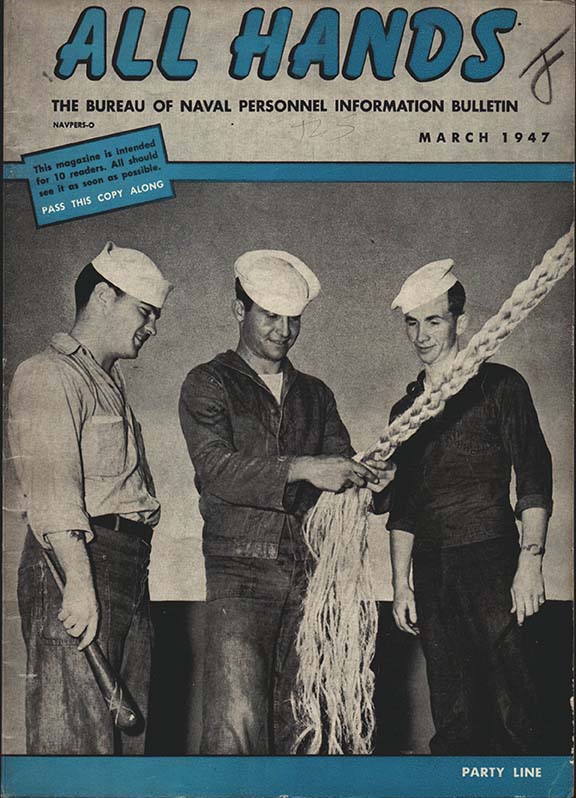 |
Warrant Officer Electrician, Rudolph G. Roth, awarded the Bronze Star Medal. Personnel may advance to new warrant grades. New warrant designations are outlined and summarized. |
| May, 1947 | 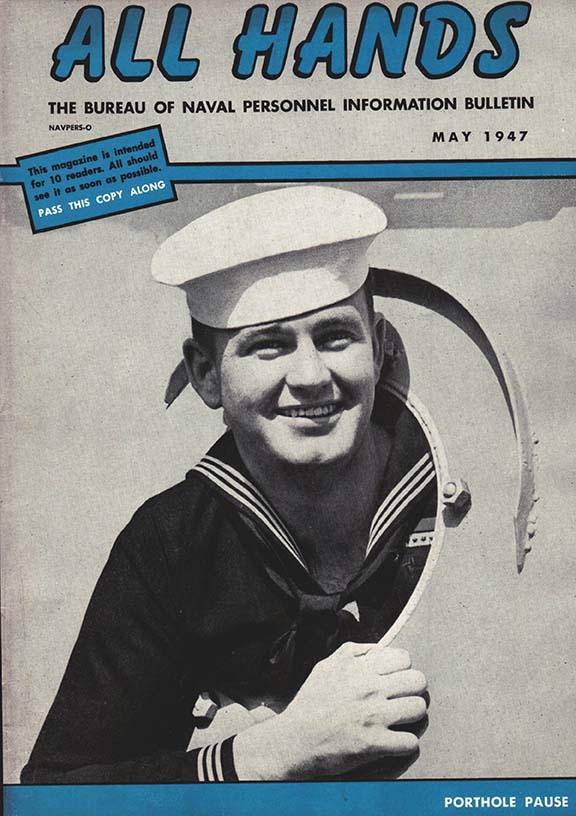 |
In the “Letters to the Editor” section, a sailor asks if a warrant rates a salute. The answer of course is yes. |
| July, 1947 | 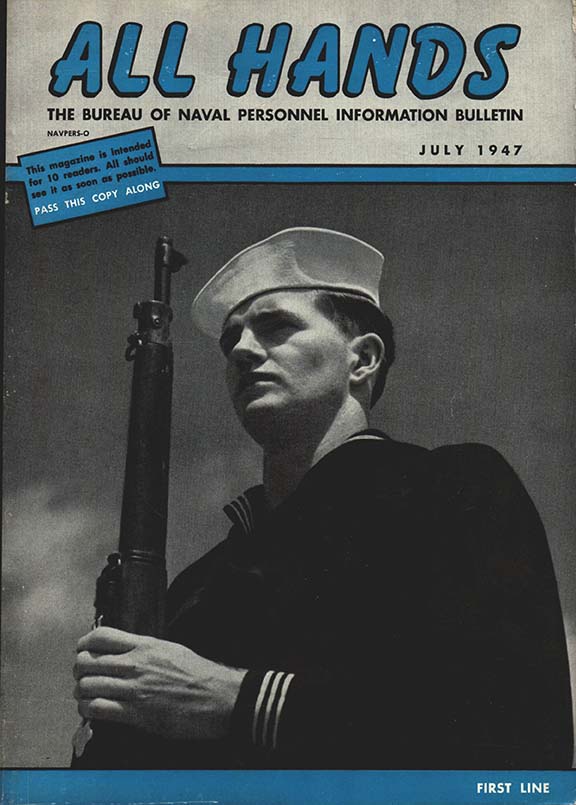 |
Warrant Officer Gunner, John N. Bennett, awarded Bronze Star Medal as Chief of the Boat during Seawolf’s 12th war patrol. |
| August, 1947 | 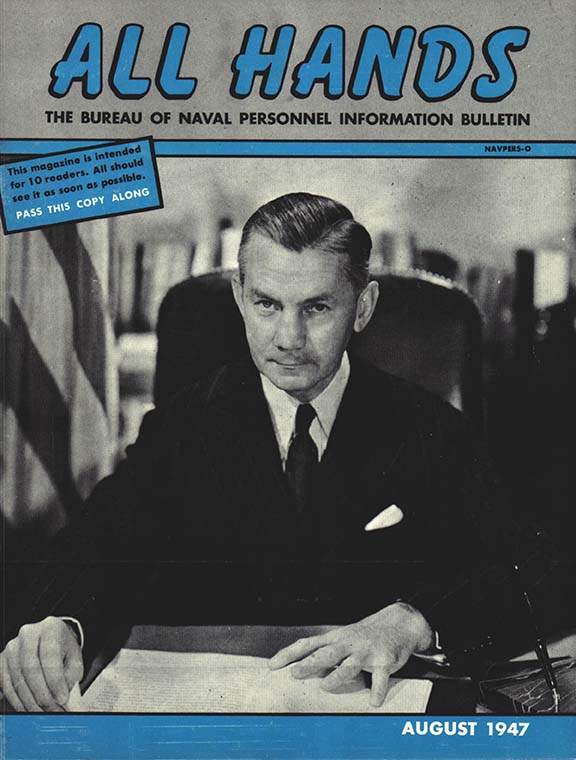 |
Warrant Officer Boatswain, Marion Frisbee, awarded the Silver Star Medal. |
| September, 1947 | 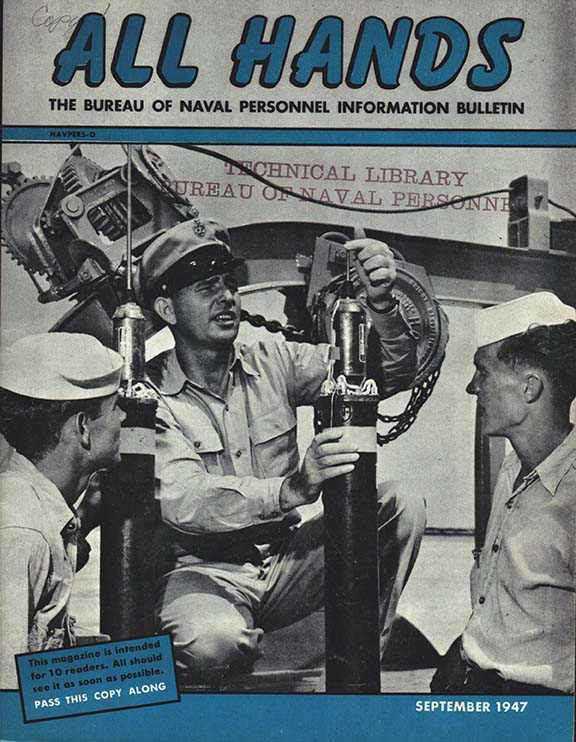 |
A Warrant Officer Boatswain, Fremon Lemoine, awarded the Navy and Marine Corps Medal. |
| October, 1947 | 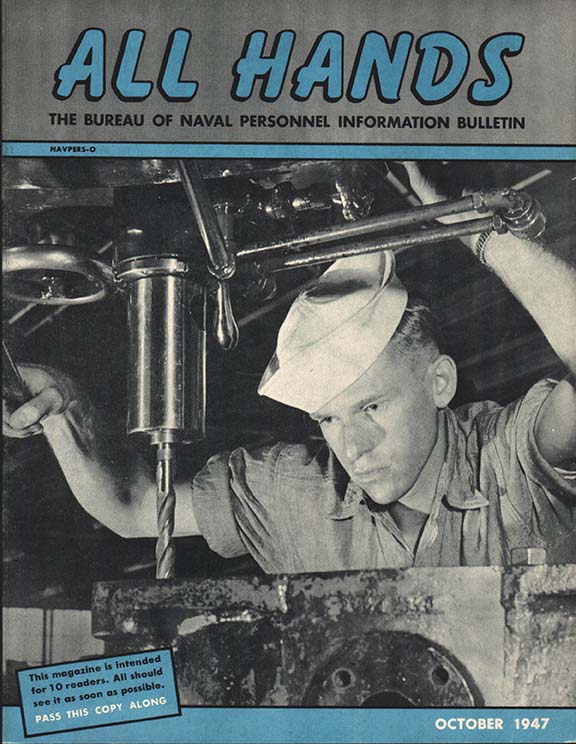 |
All Hands wrote an article about the establishment of the Limited Duty Officer program. Interesting fact: CWOs with over 28 years of service were eligible for selection to O-5. |
| December, 1947 | 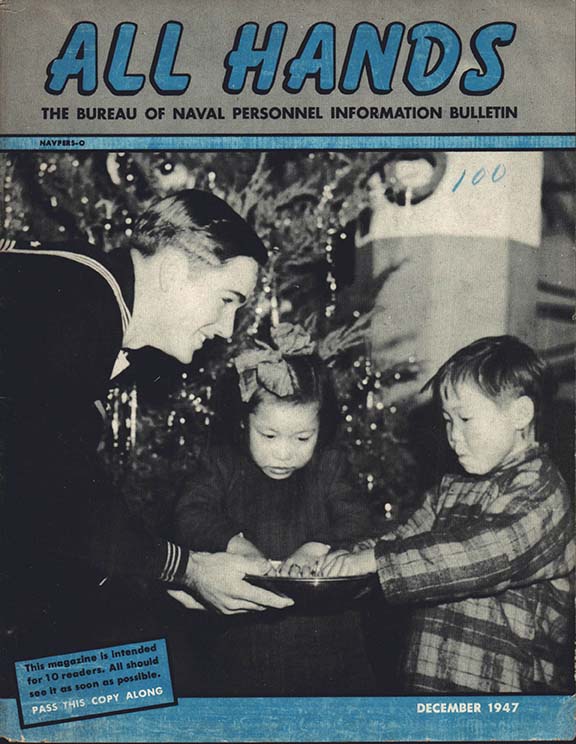 |
Chief Warrant Officer Carpenter, Lester J. Schnable, awarded the Silver Star Medal. |
| February, 1948 | 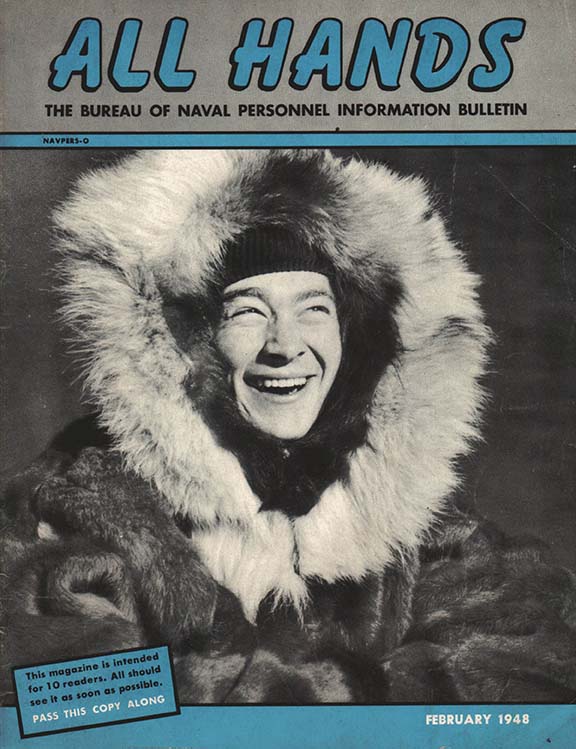 |
A board convened to study retirement laws is considering the commissioned time as a CWO to count towards the minimum 10 year commissioned time to retire as an LDO. A Warrant Officer Machinist, William E. Green, was awarded the Silver Star Medal. |
| March, 1948 | 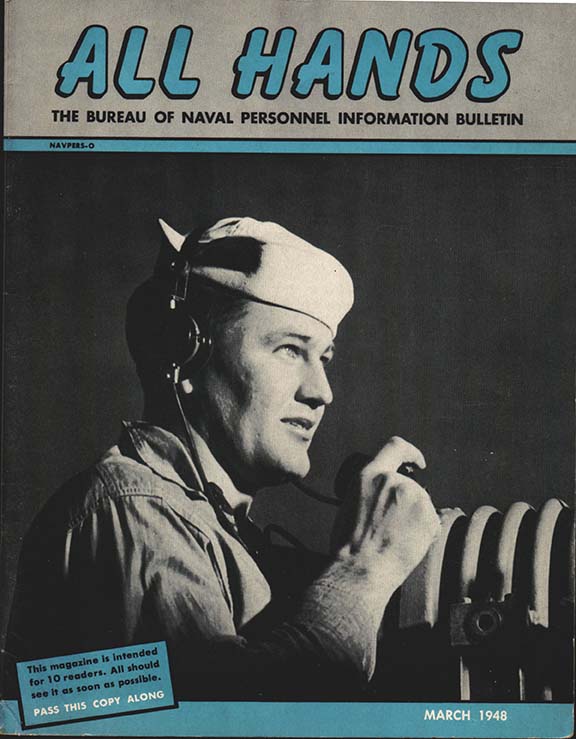 |
Warrant Officers assigned numeric code designators. A detailed table shows the new enlisted and warrant structure. |
| July, 1948 | 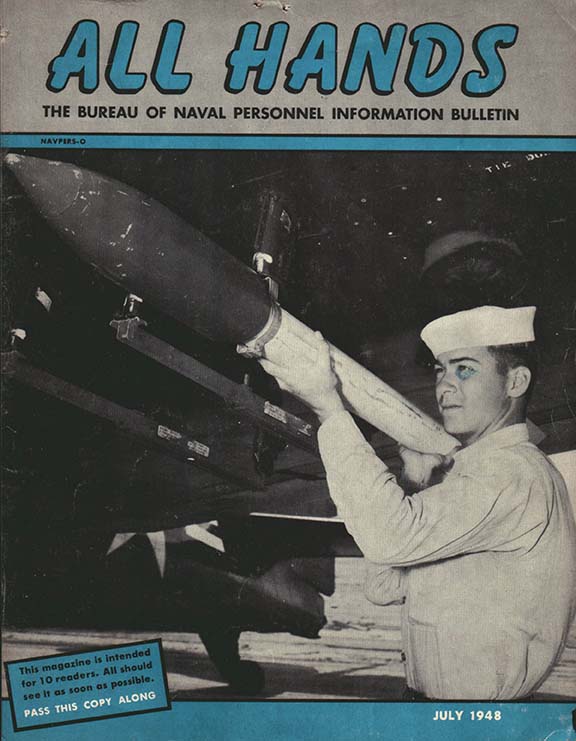 |
A Warrant Officer Boatswain, Robert F. Hanseroth, was awarded the Navy and Marine Corps Medal. |
| August, 1948 | 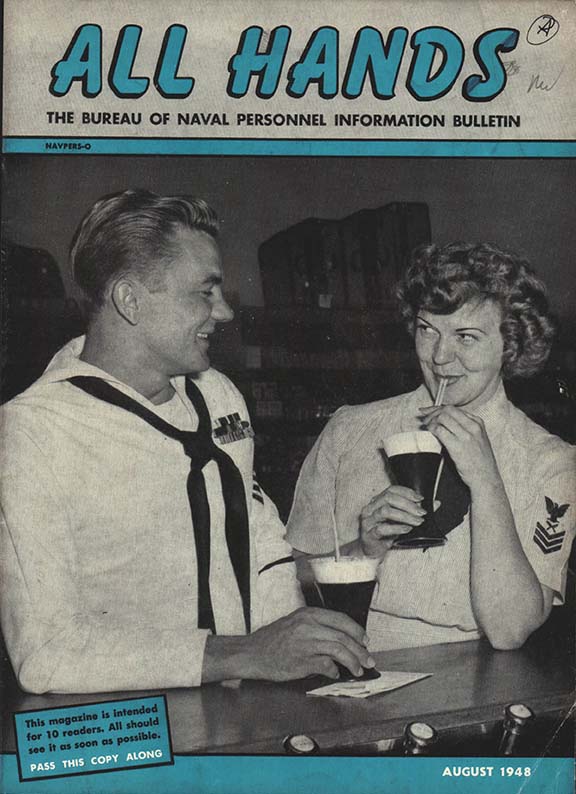 |
There are 4,097 active duty warrant officers making up 11% of all officers and 1% of the entire Navy. Congressional Medal of Honor awarded to Warrant Officer Gunner, Jackson C. Pharris (now a retired LCDR) from actions when his ship was hit with a torpedo in 1941. |
| January, 1949 | 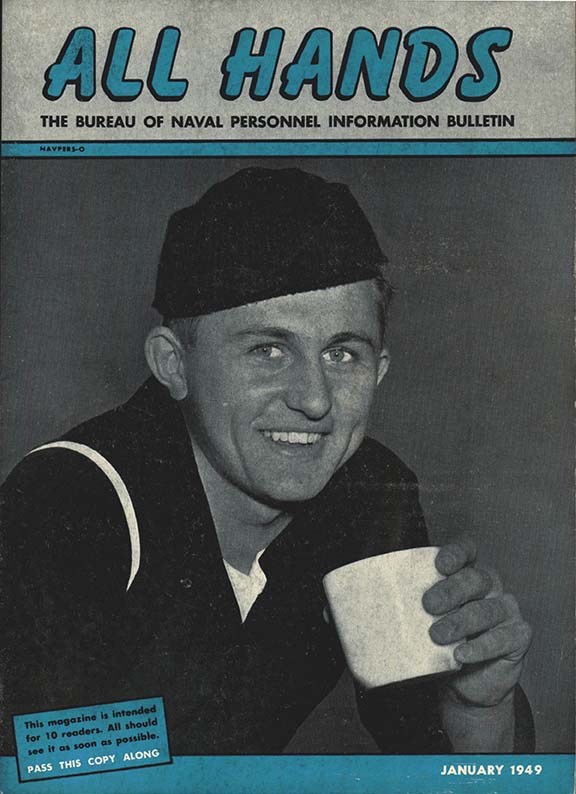 |
The second annual “Mustang Convention” of the Association of Naval Officers From the Ranks scheduled for Saturday, 5 March, at Norfolk, VA. |
| February, 1949 | 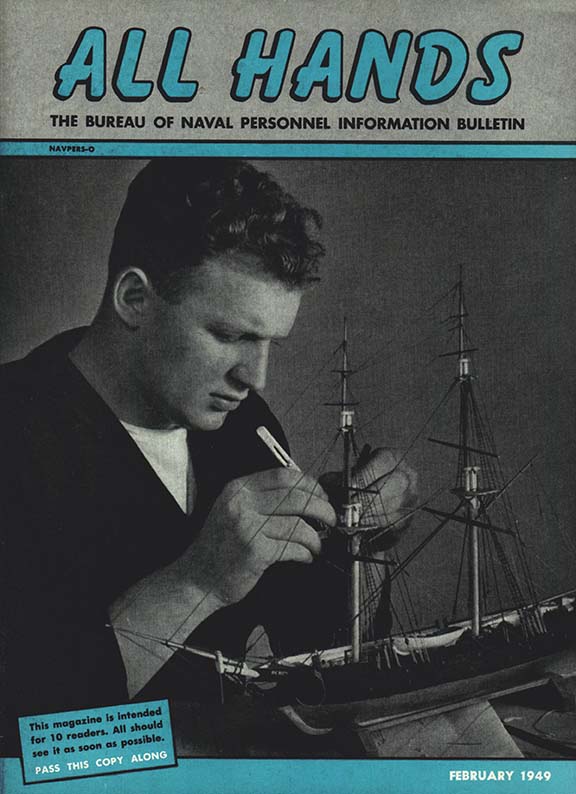 |
A chart shoes the correct abbreviations of Navy ranks/ratings. CHBOSN, CHGUN, and CHELEC are examples of how CWO Boatswains, Gunners, and Electricians are abbreviated. |
| April, 1949 | 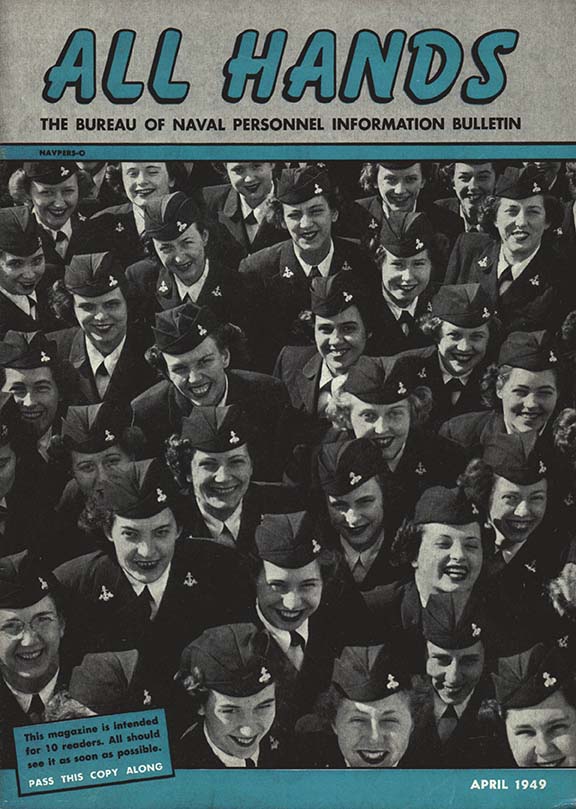 |
Chief Warrant Officer Machinist, Bryan L. Brady, awarded the Navy Cross for rescuing for sailors after their ship was struck by a mine. |


